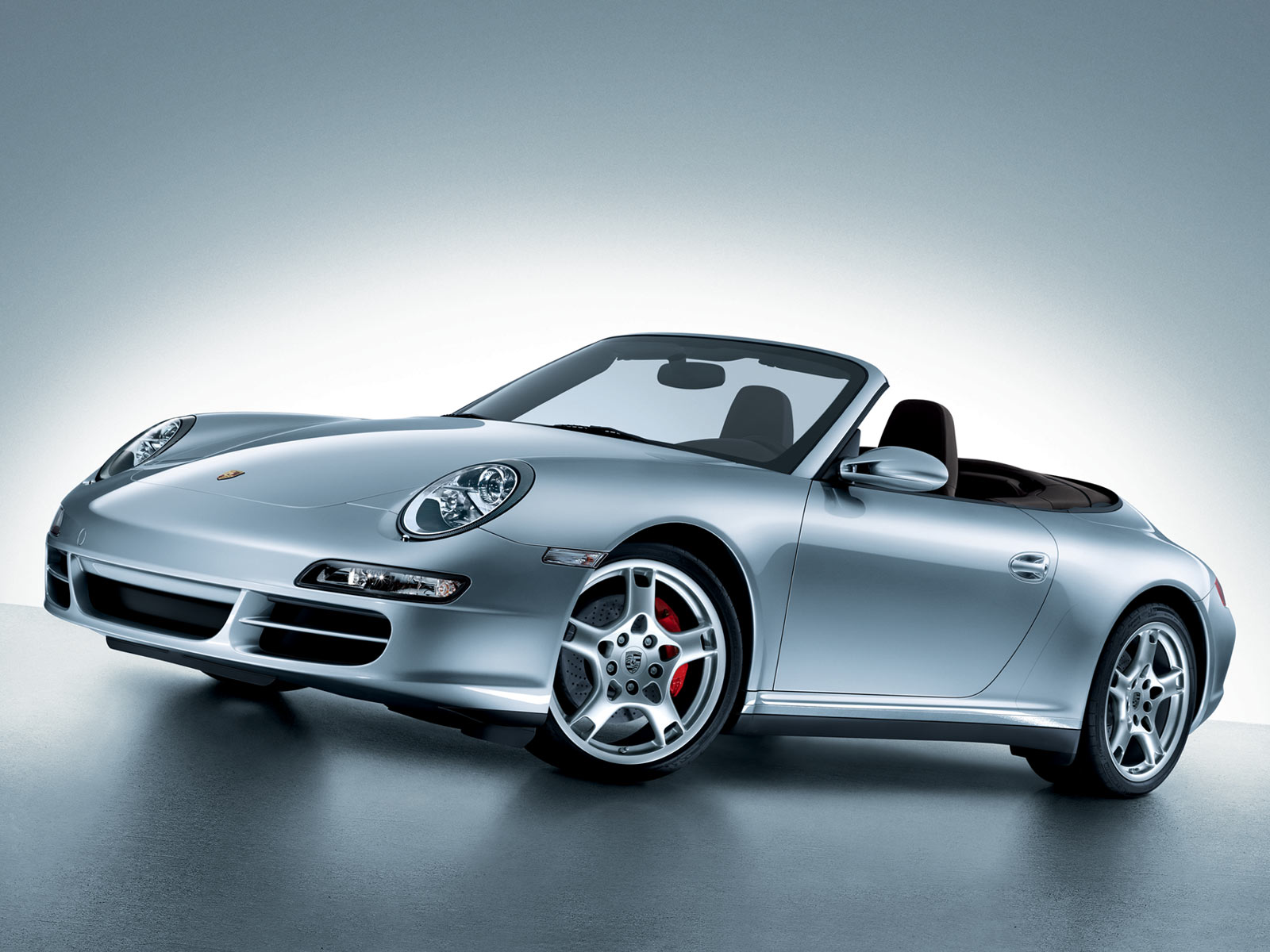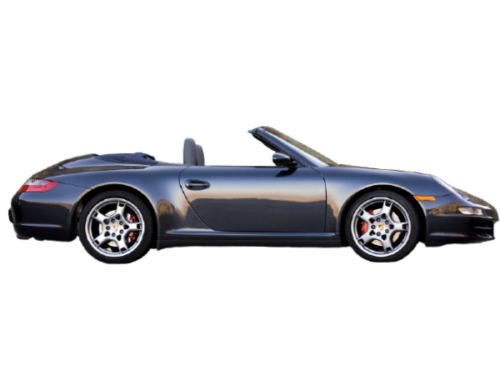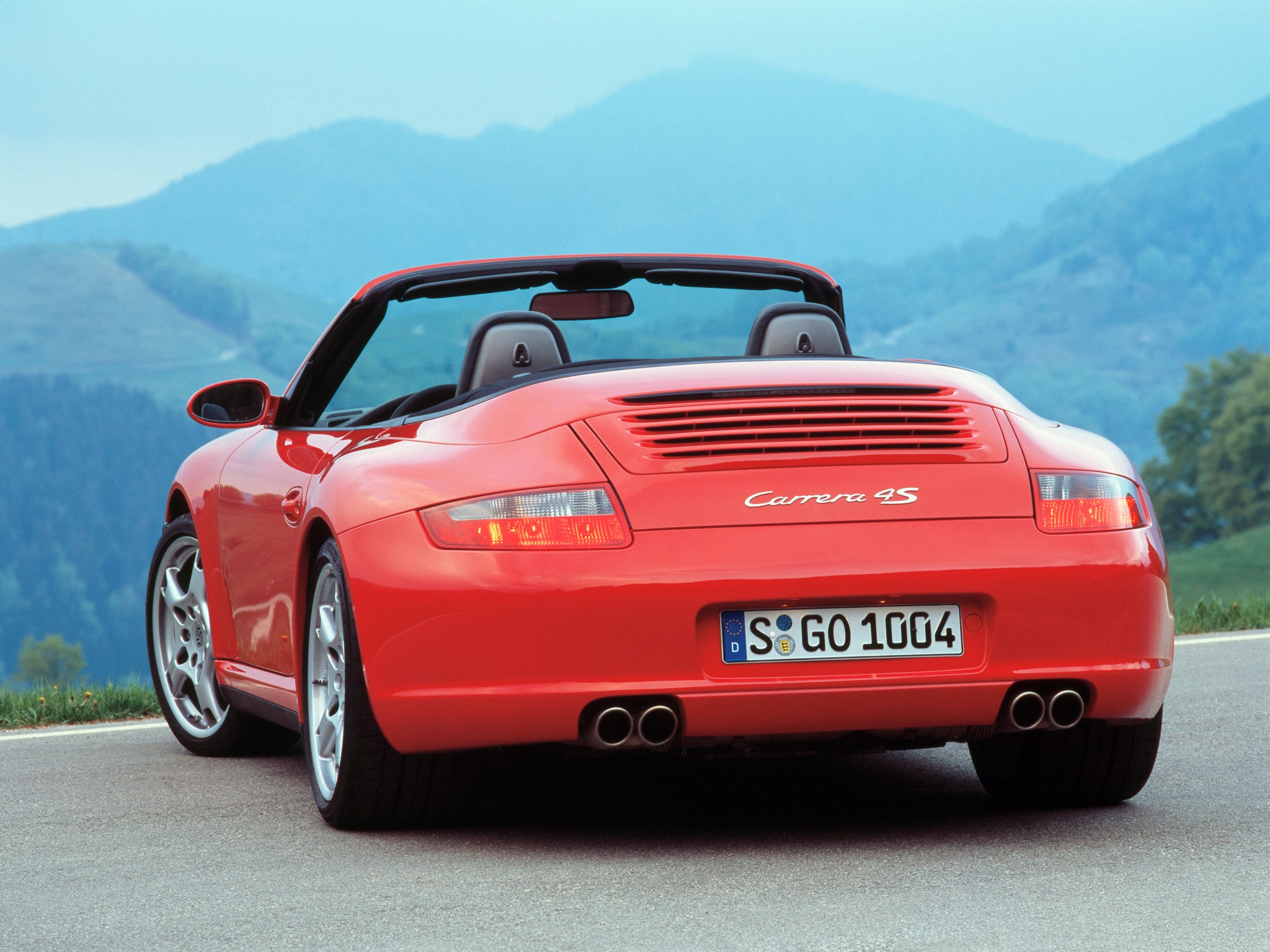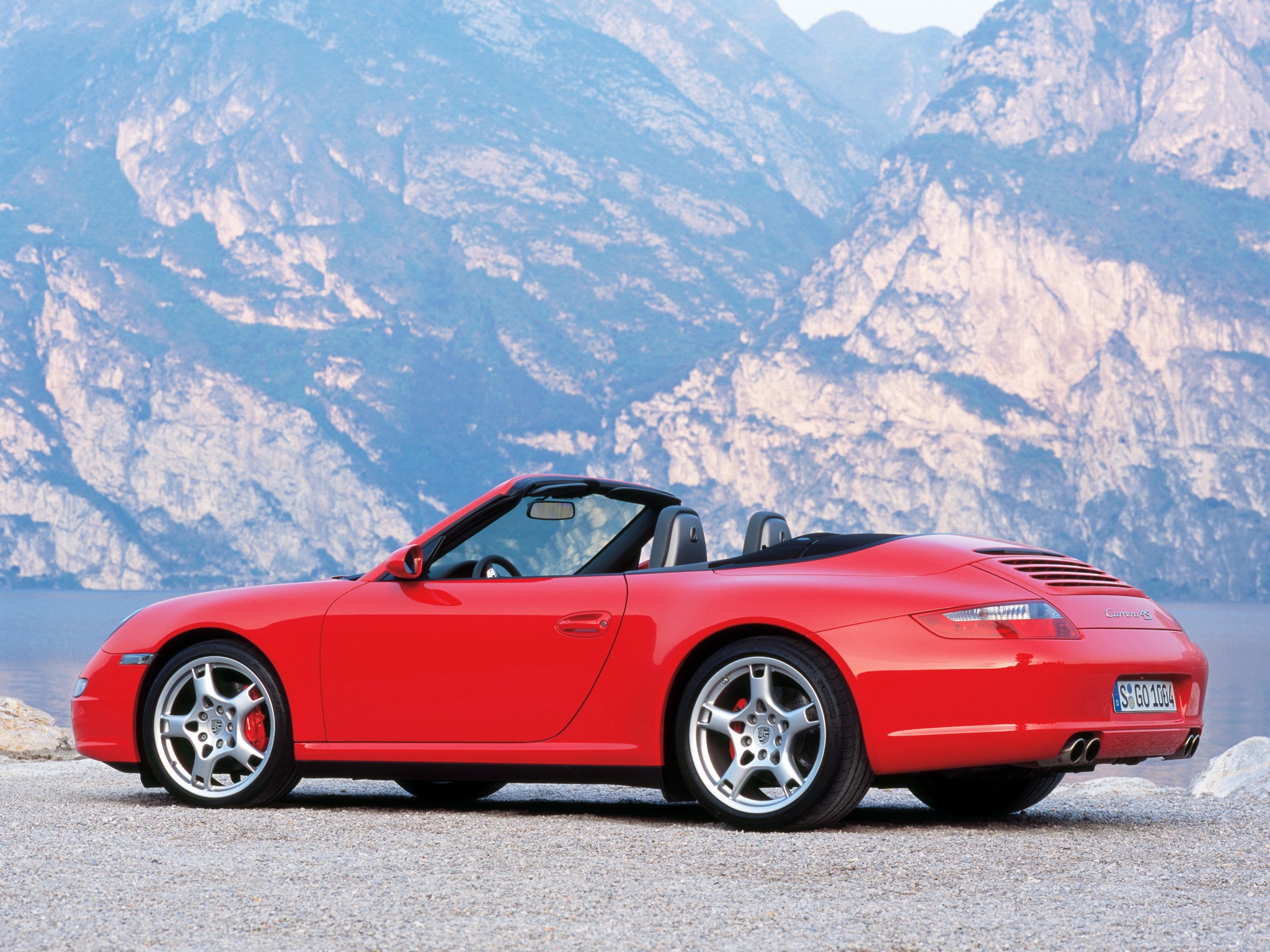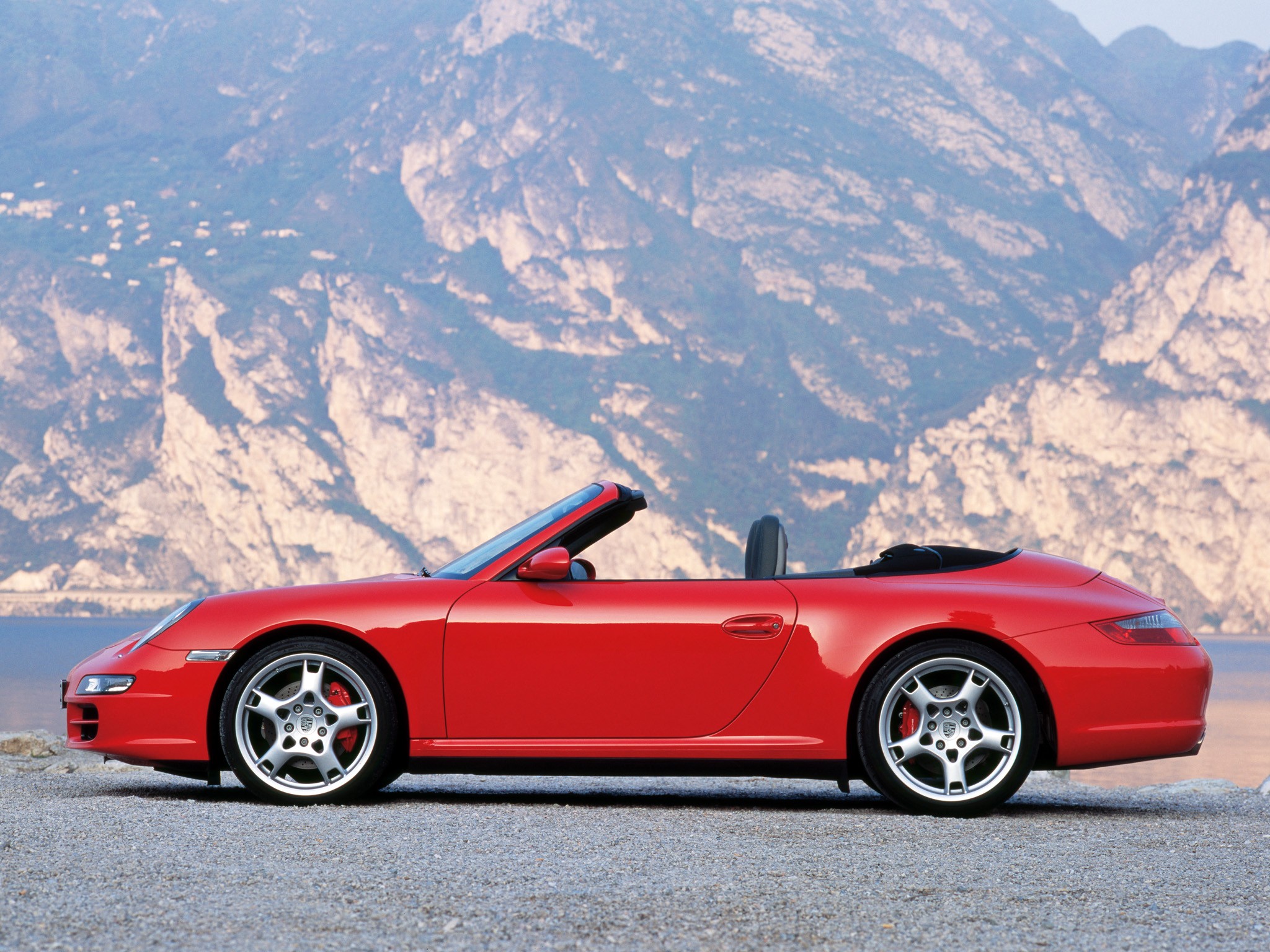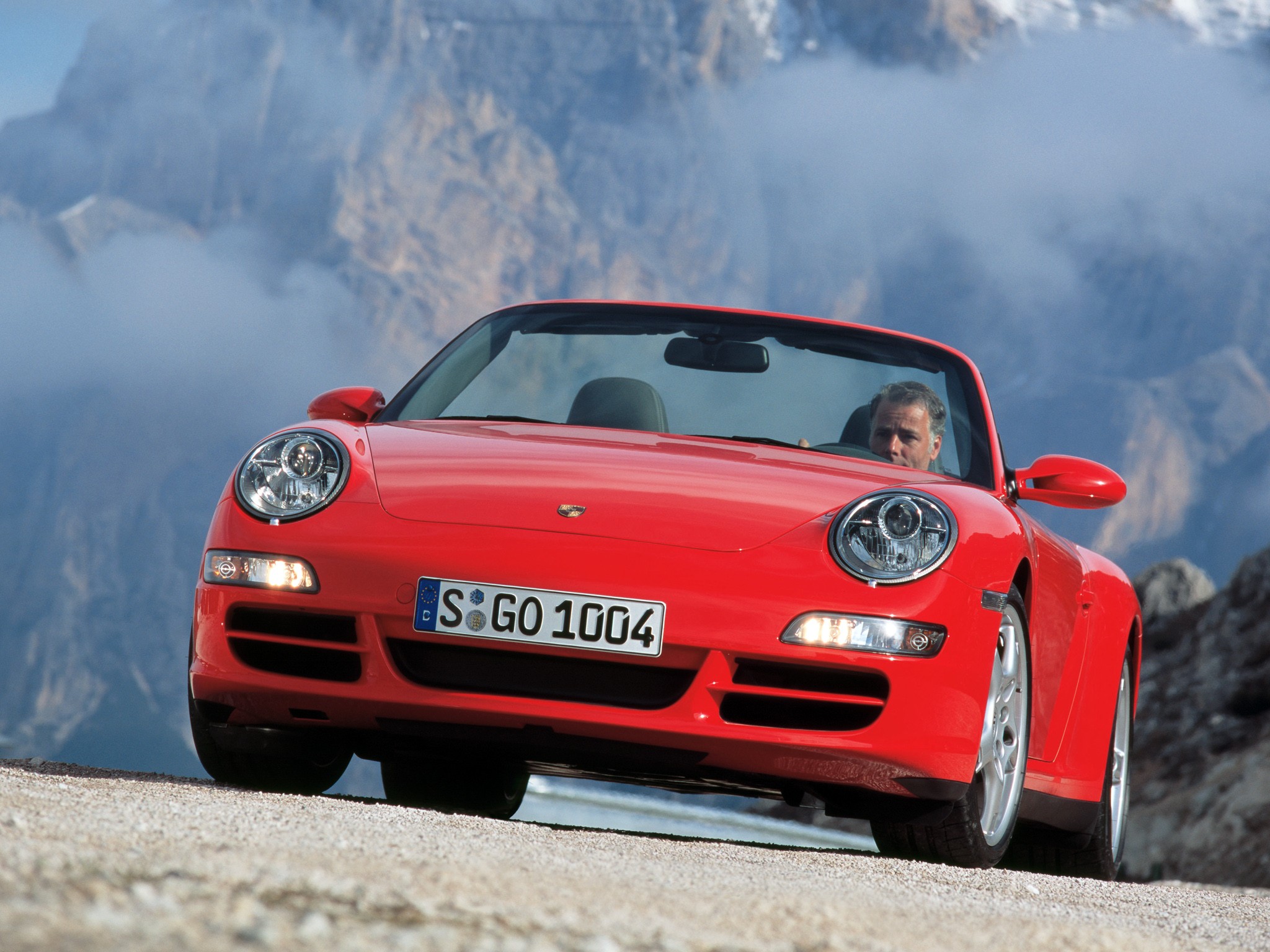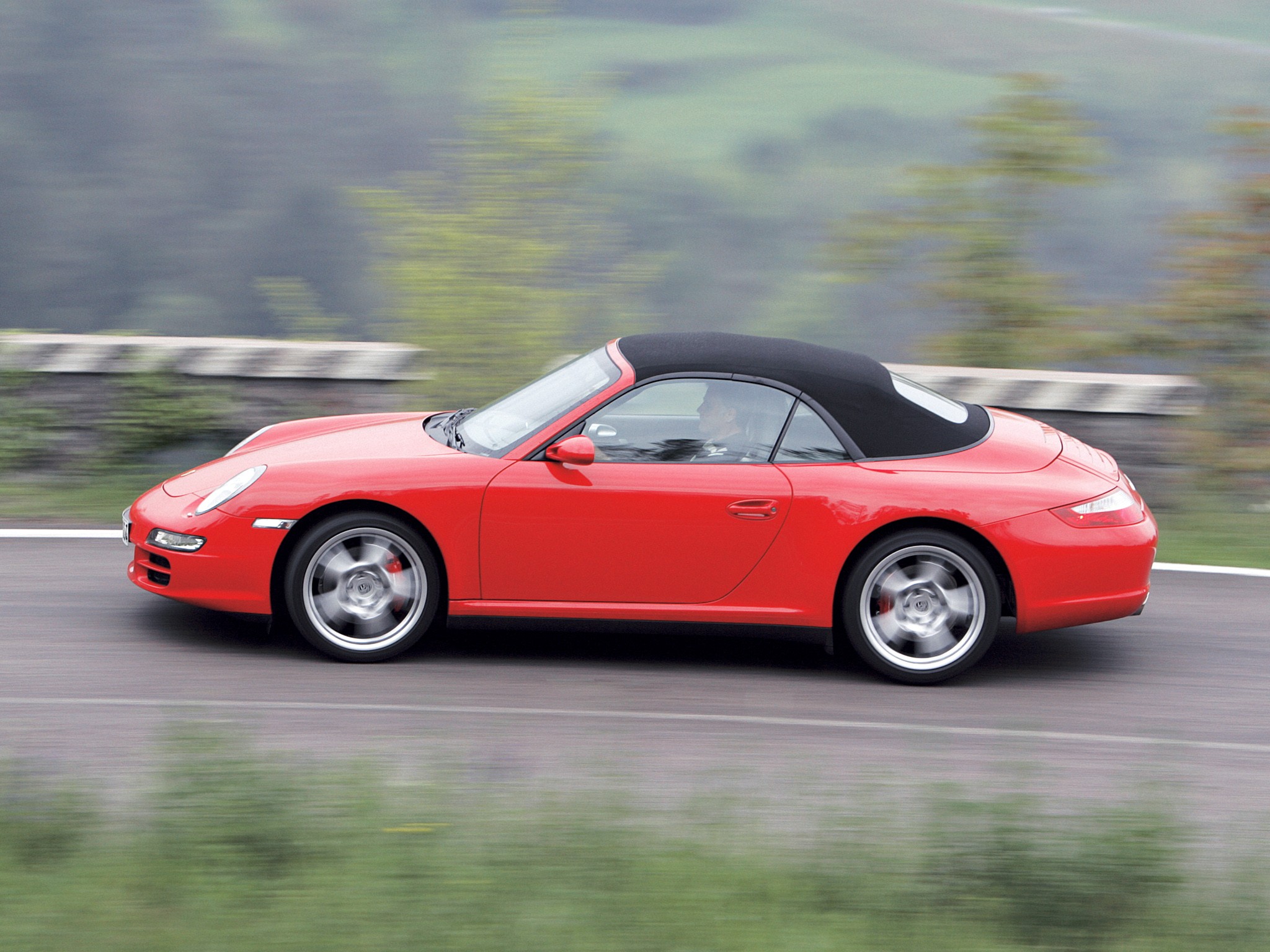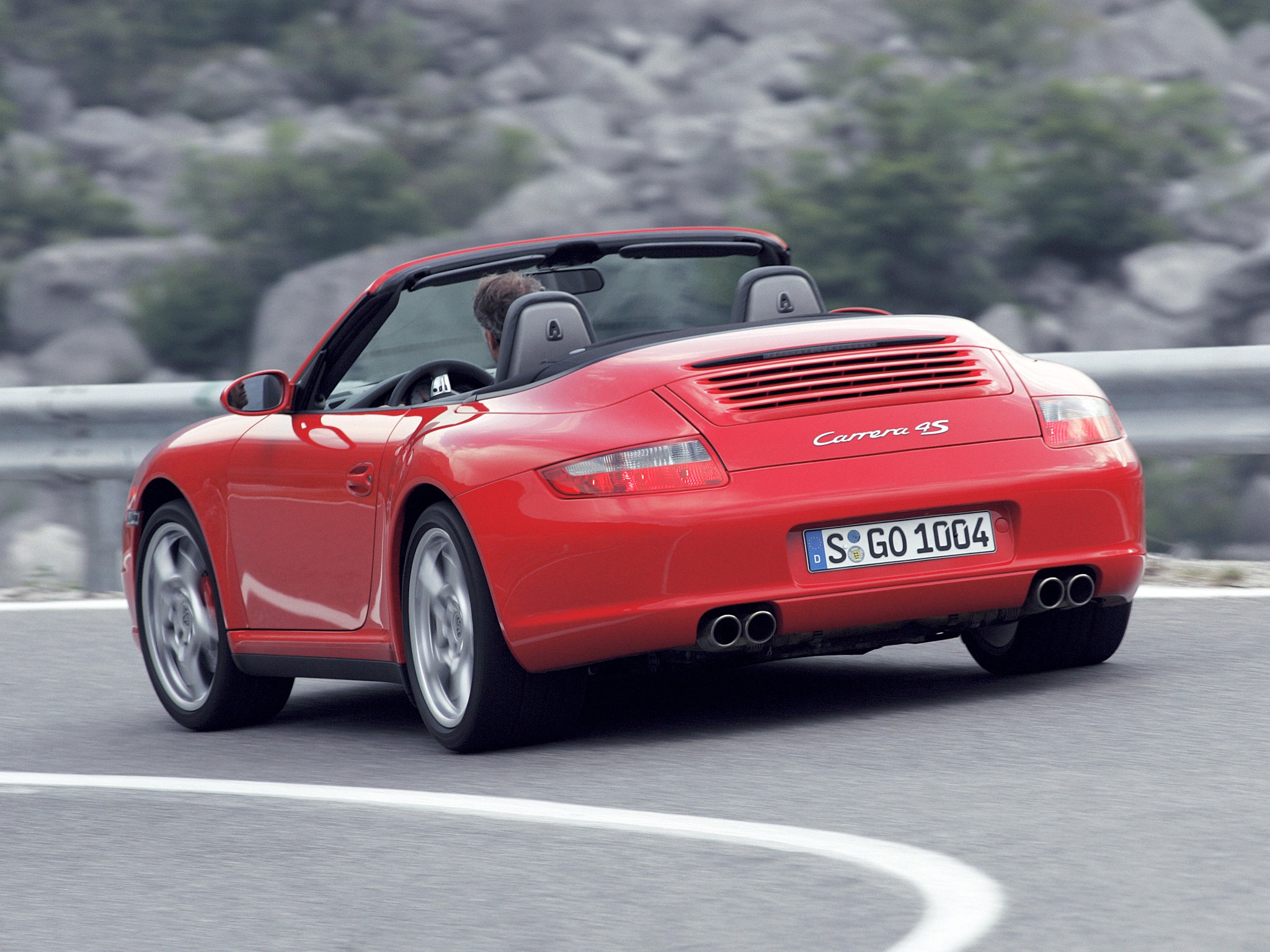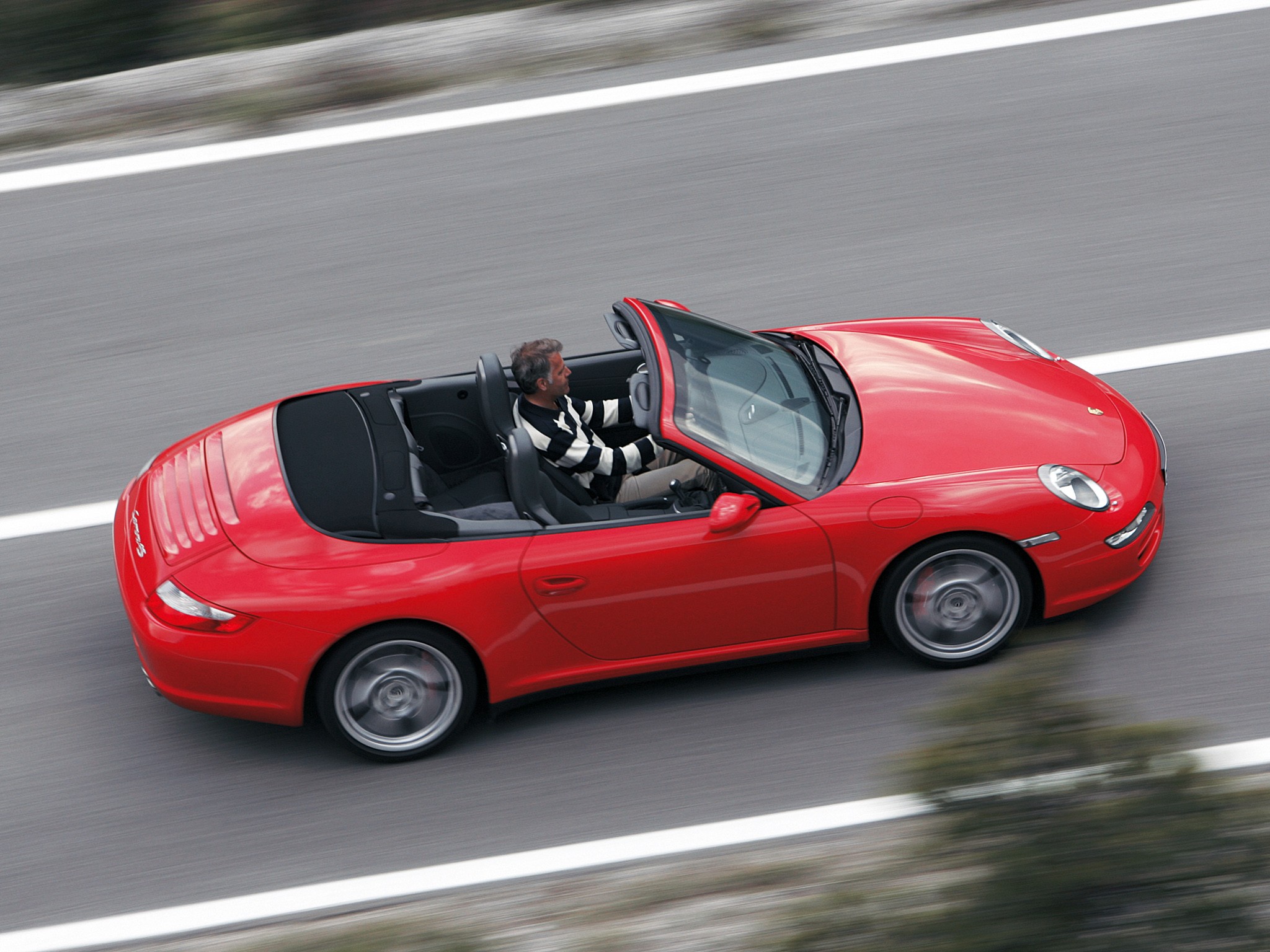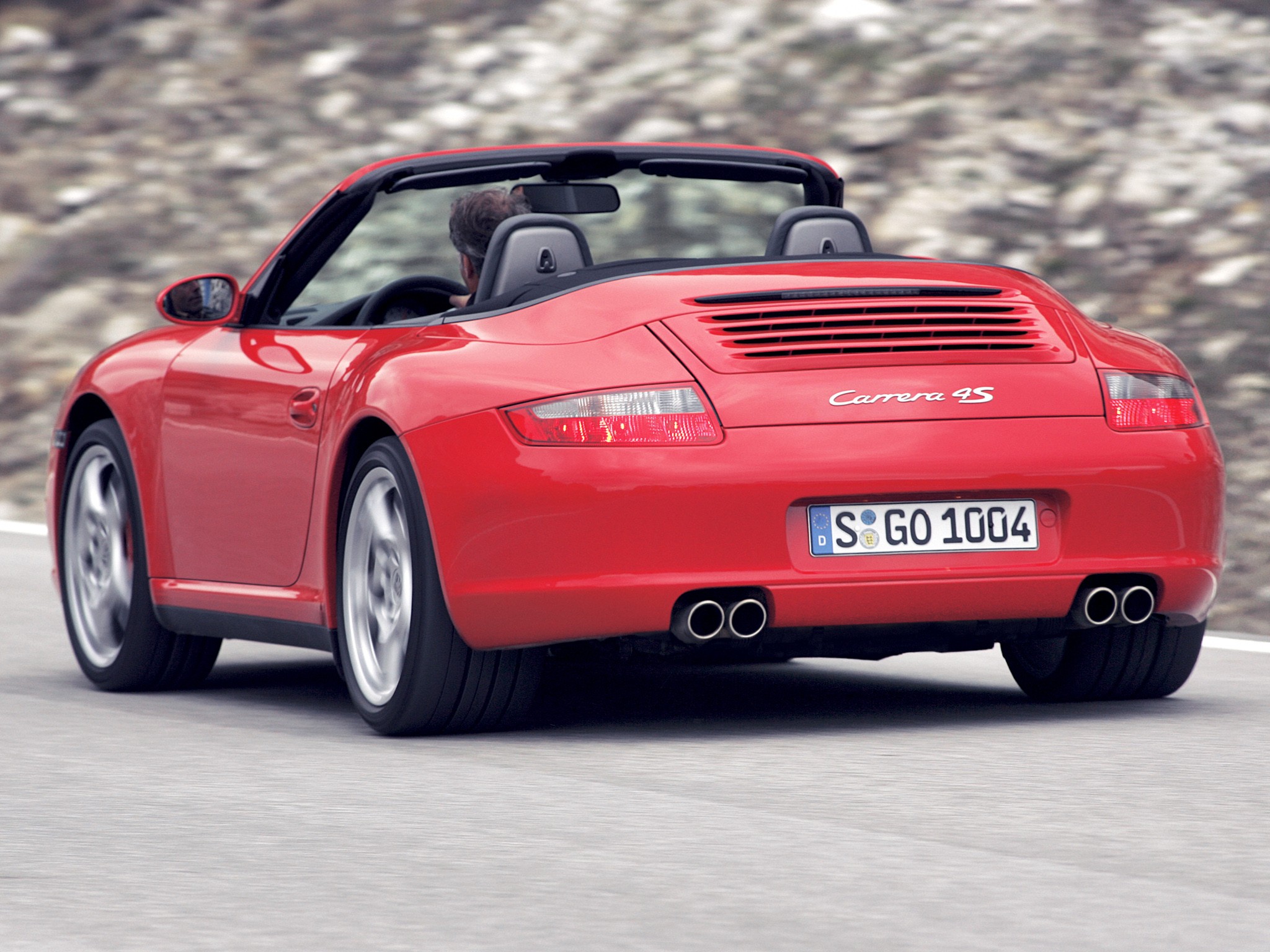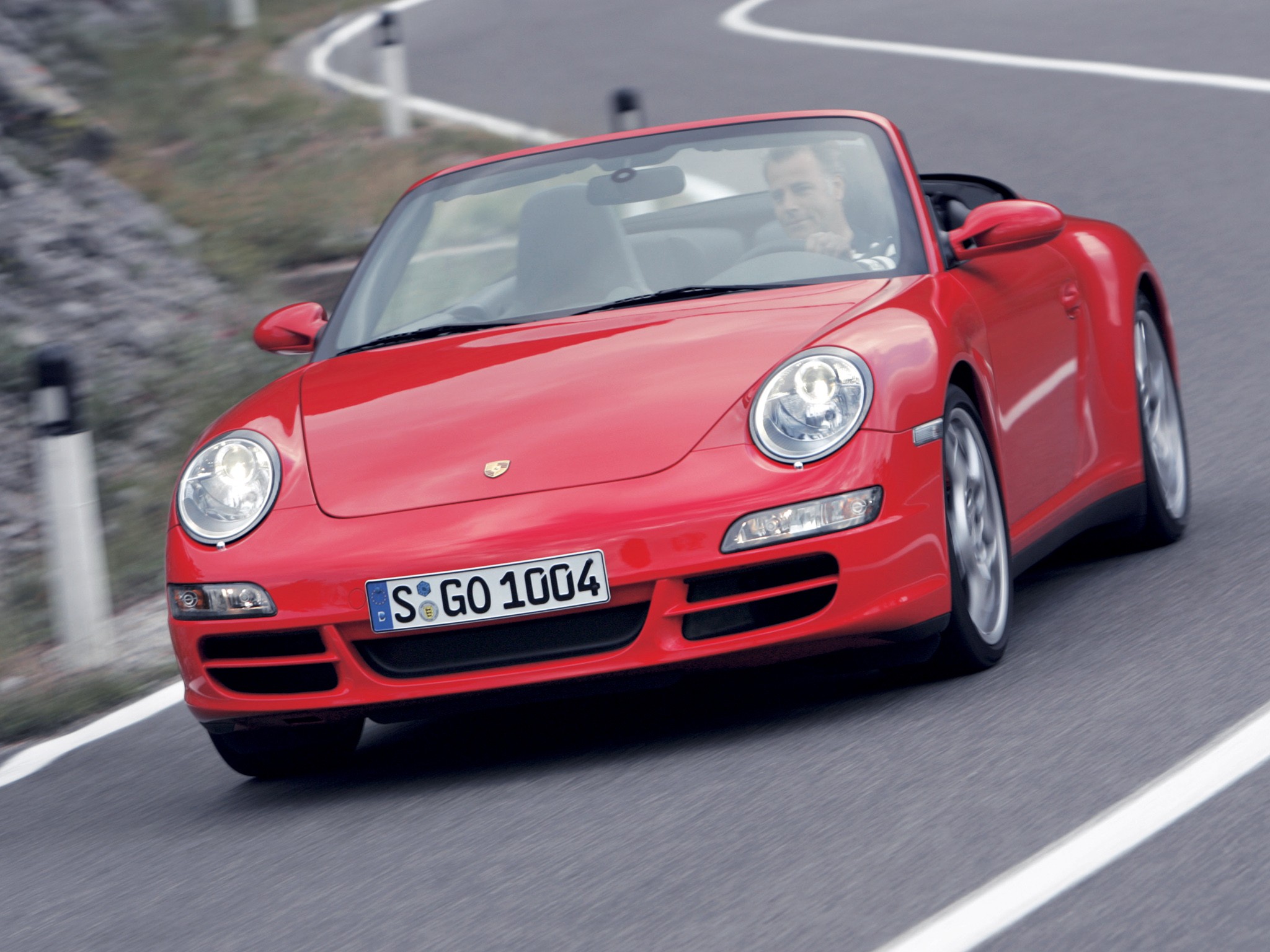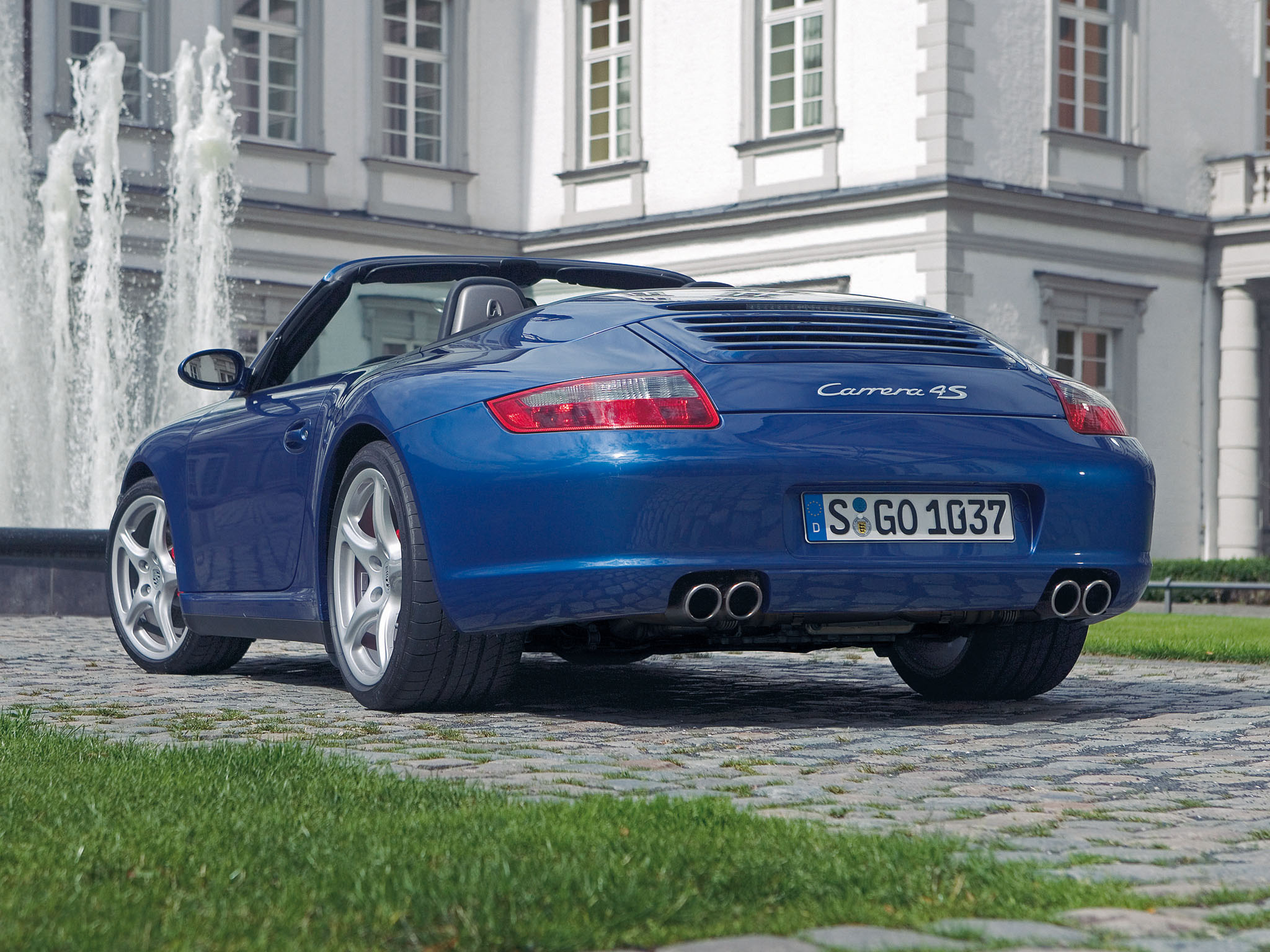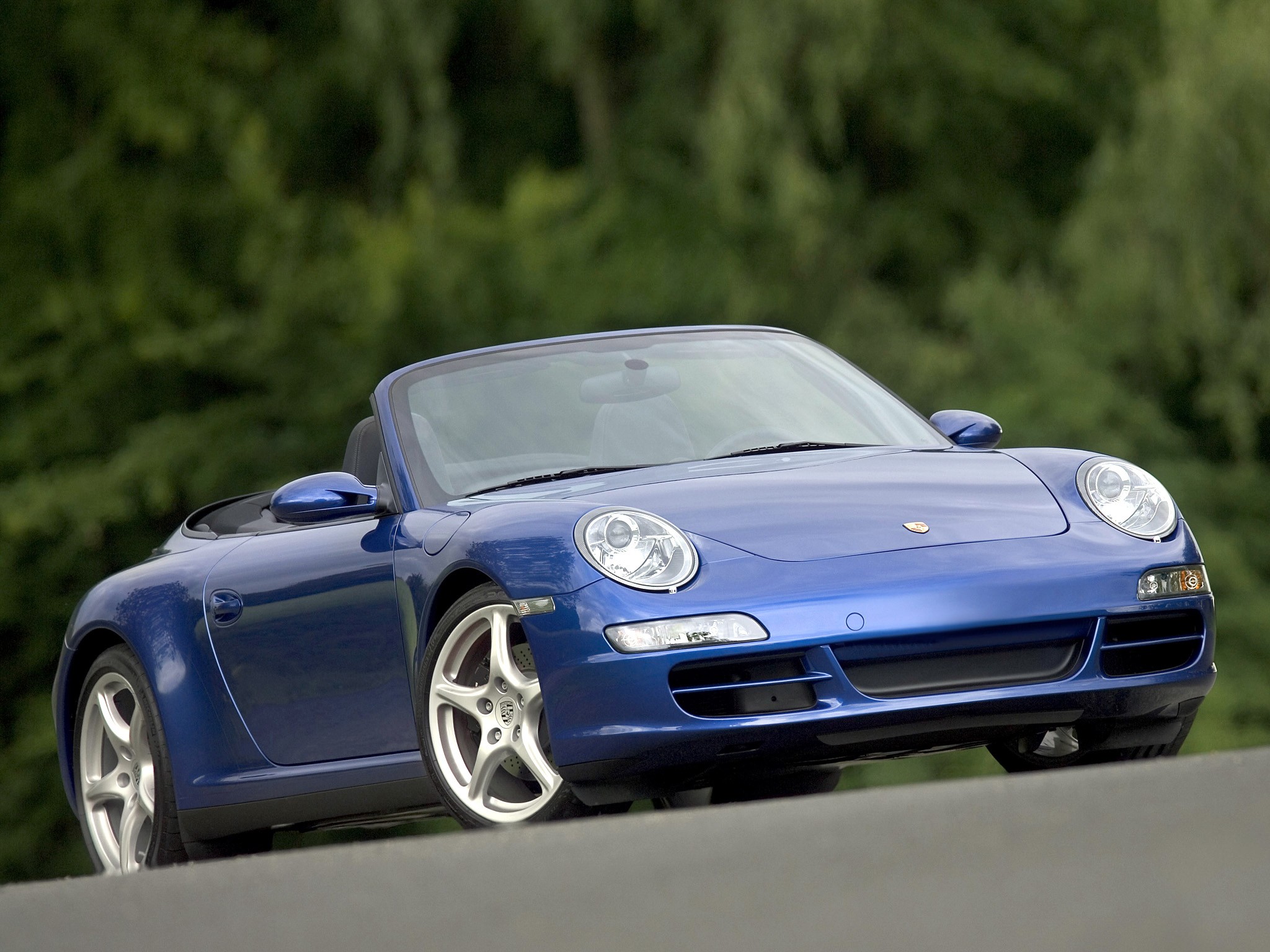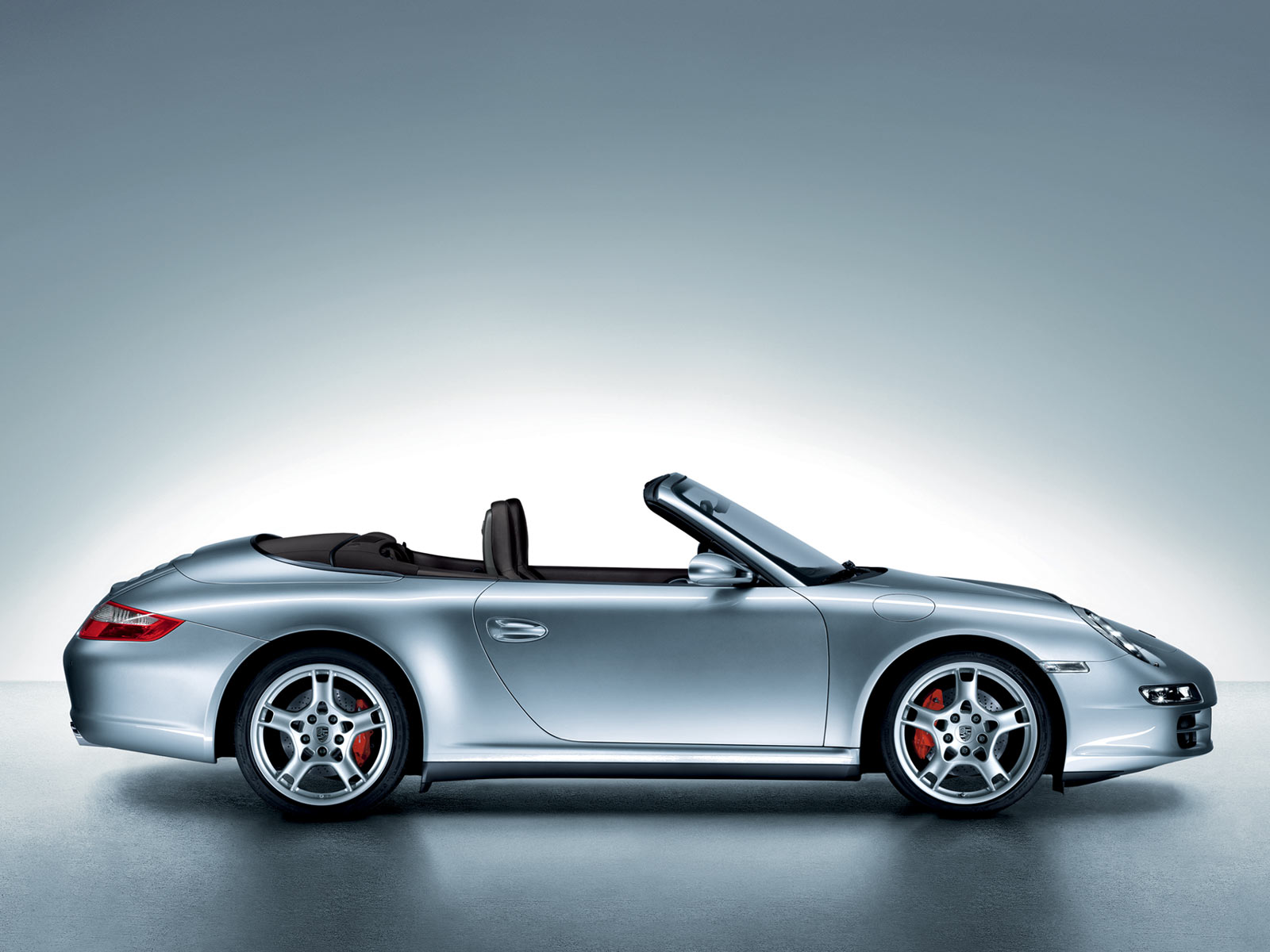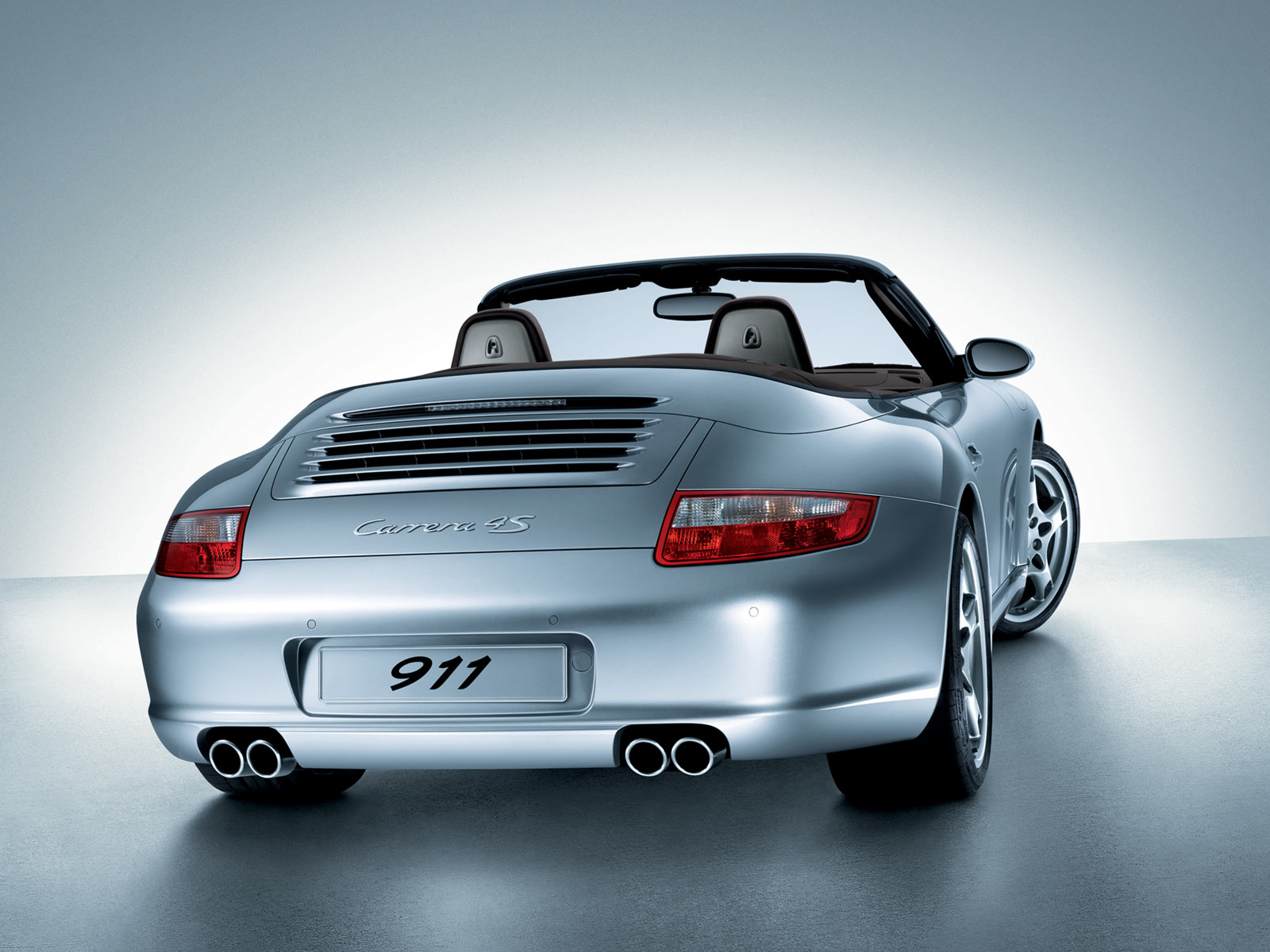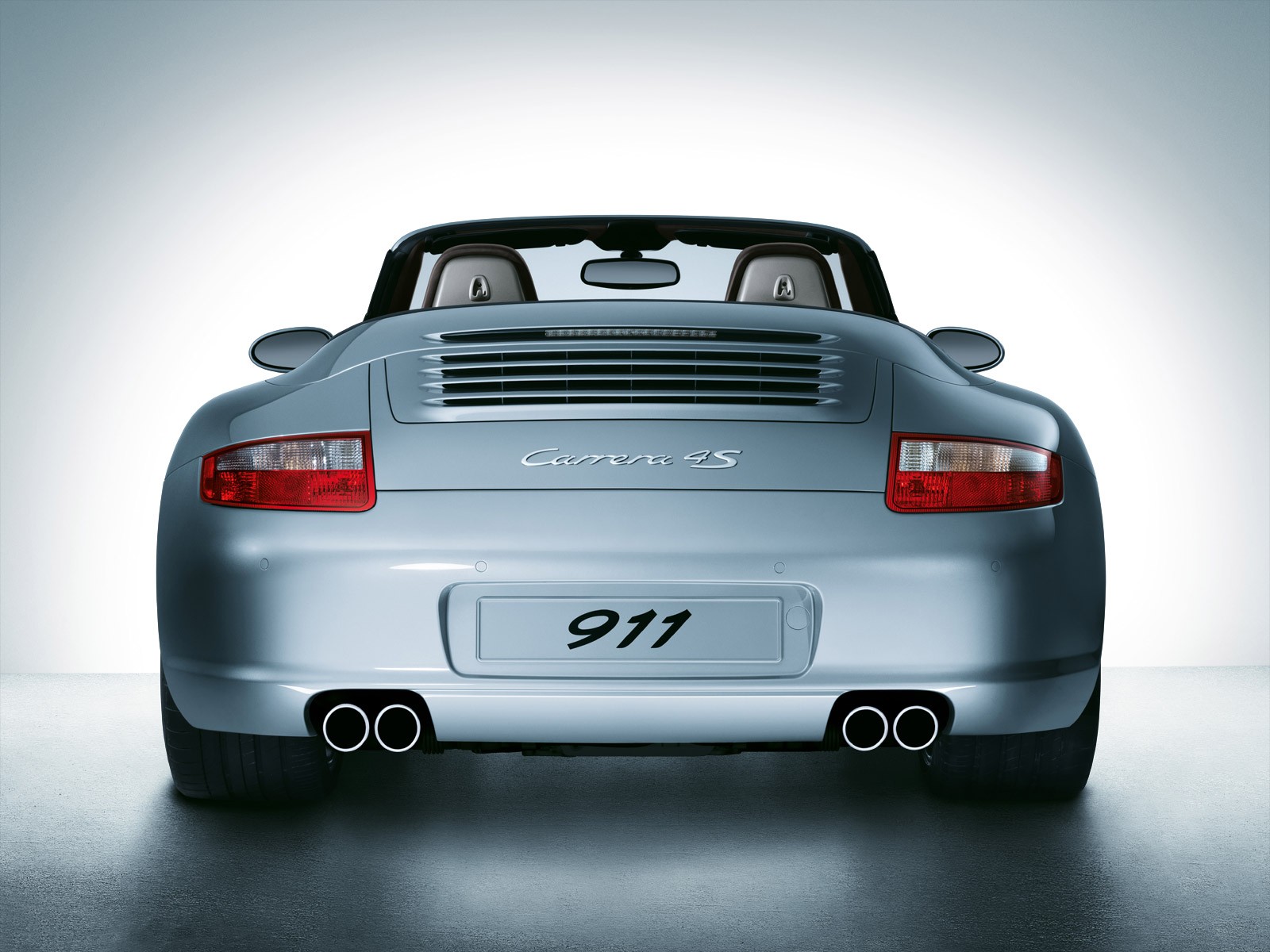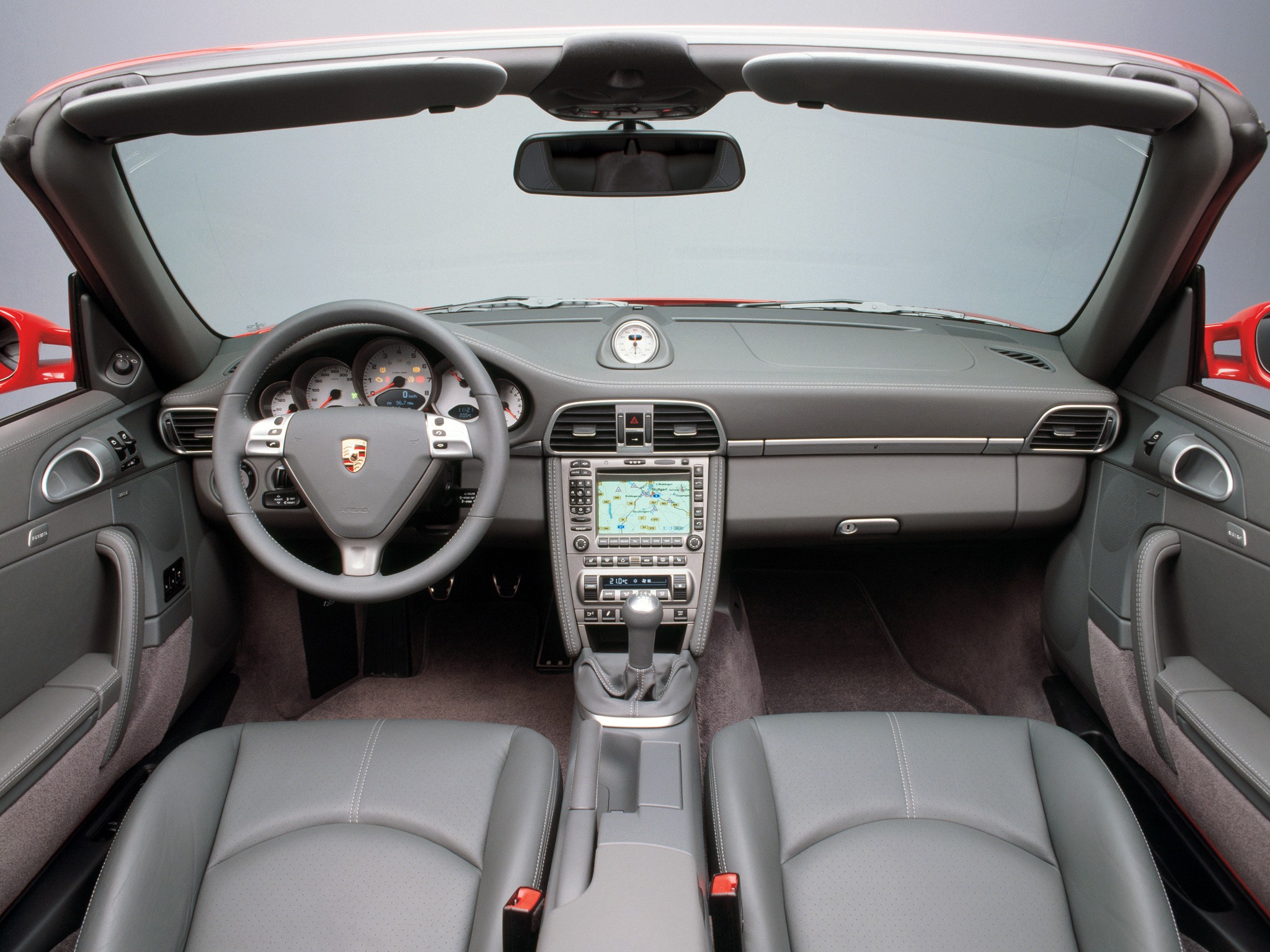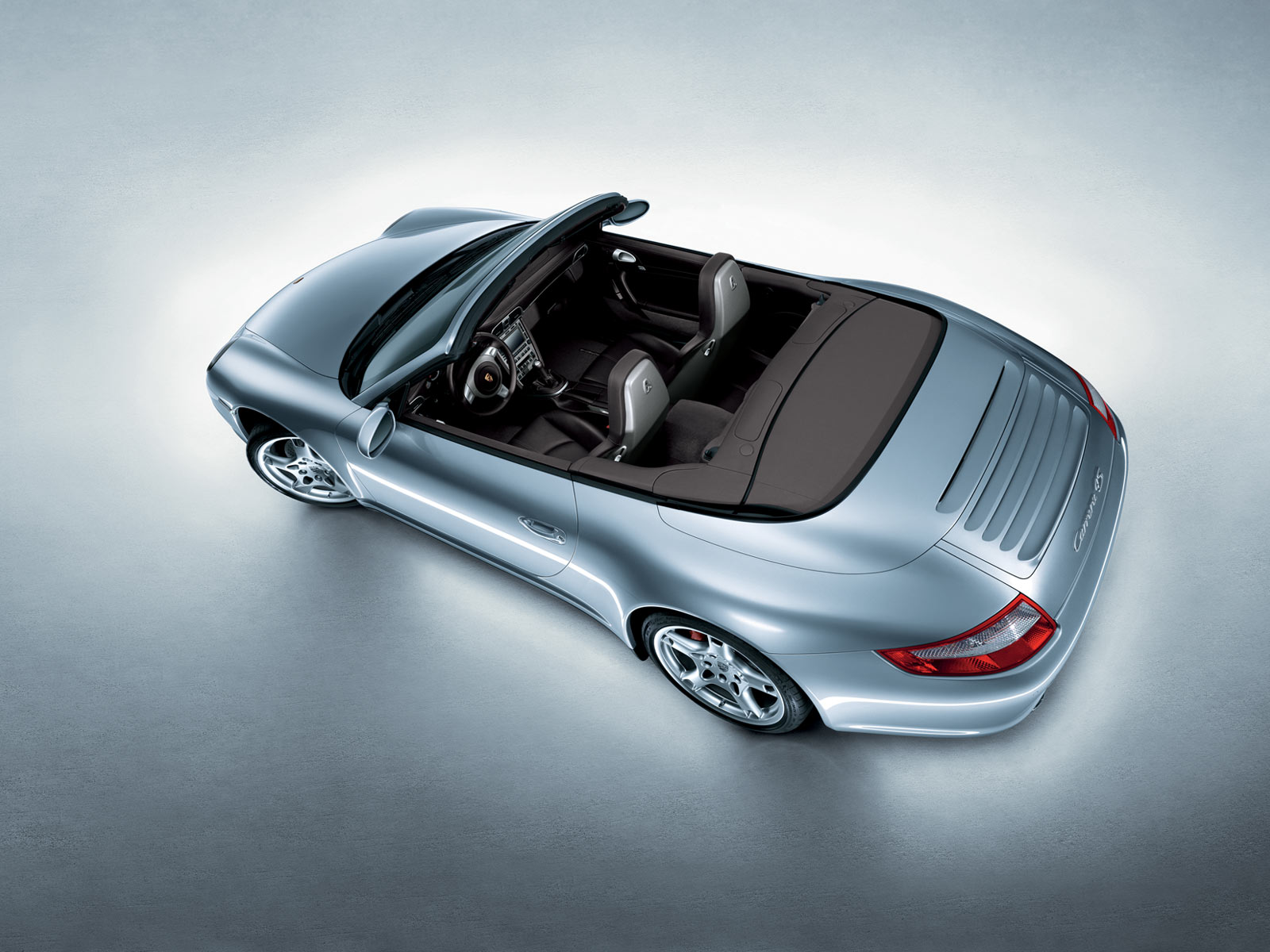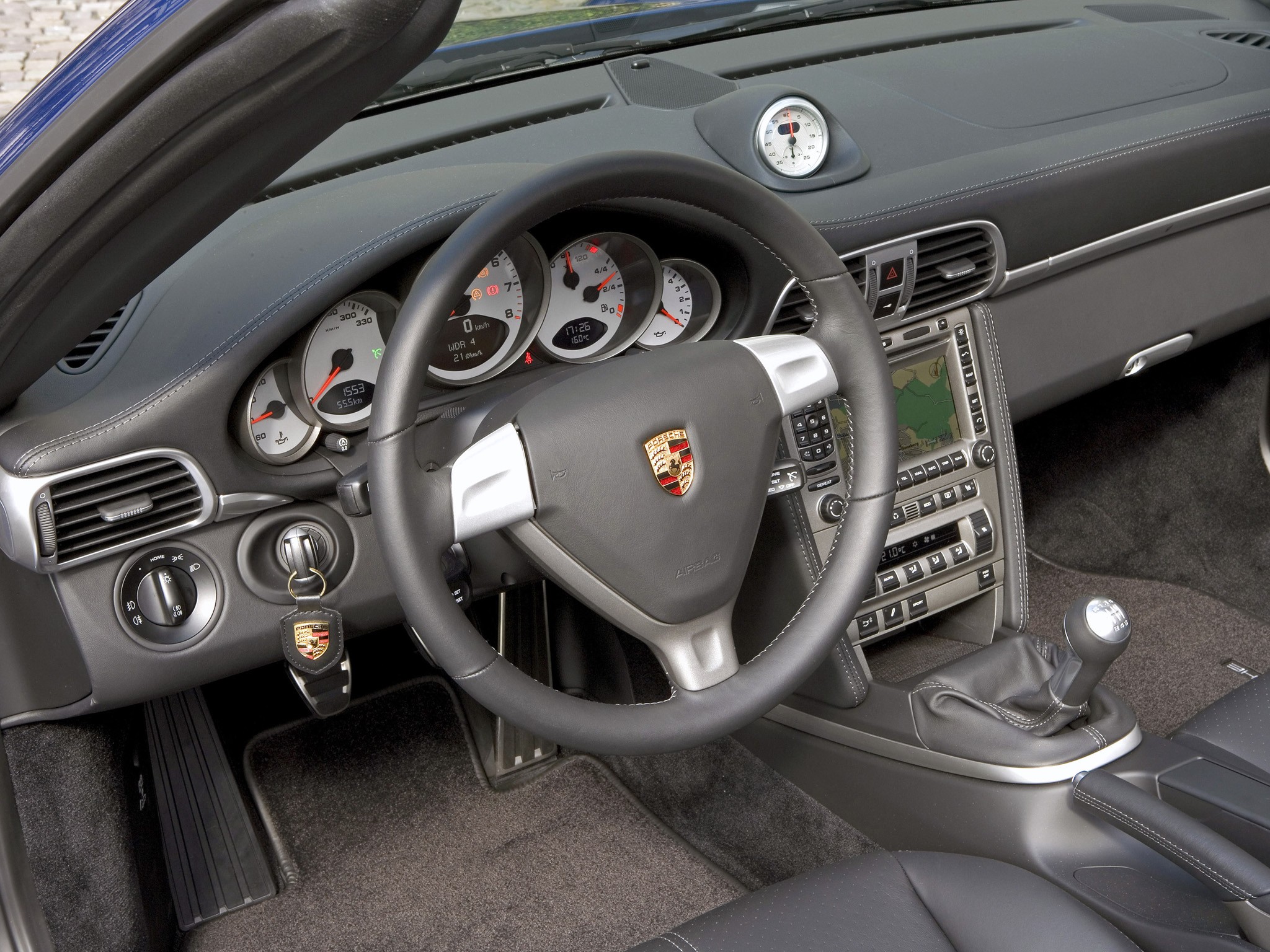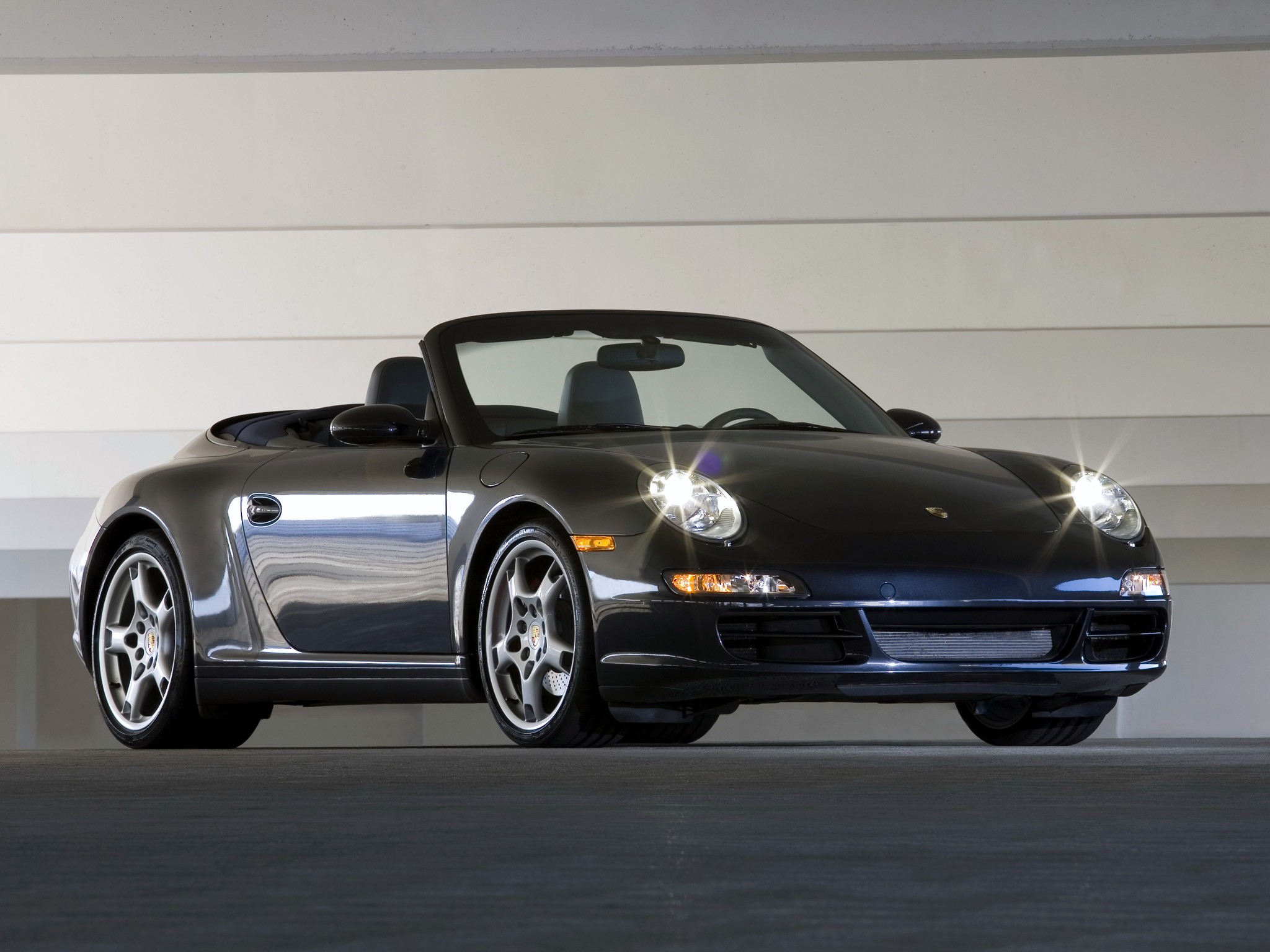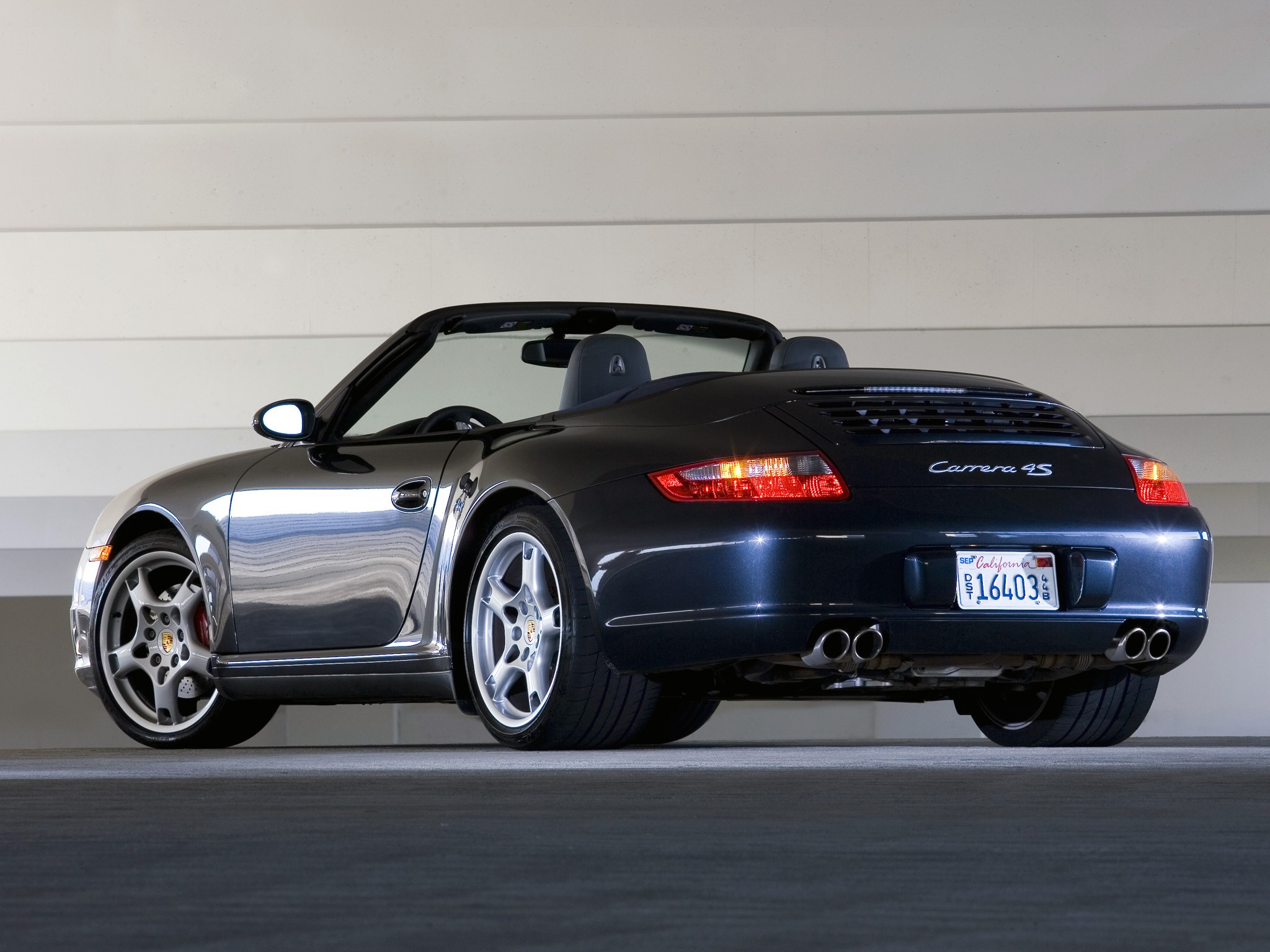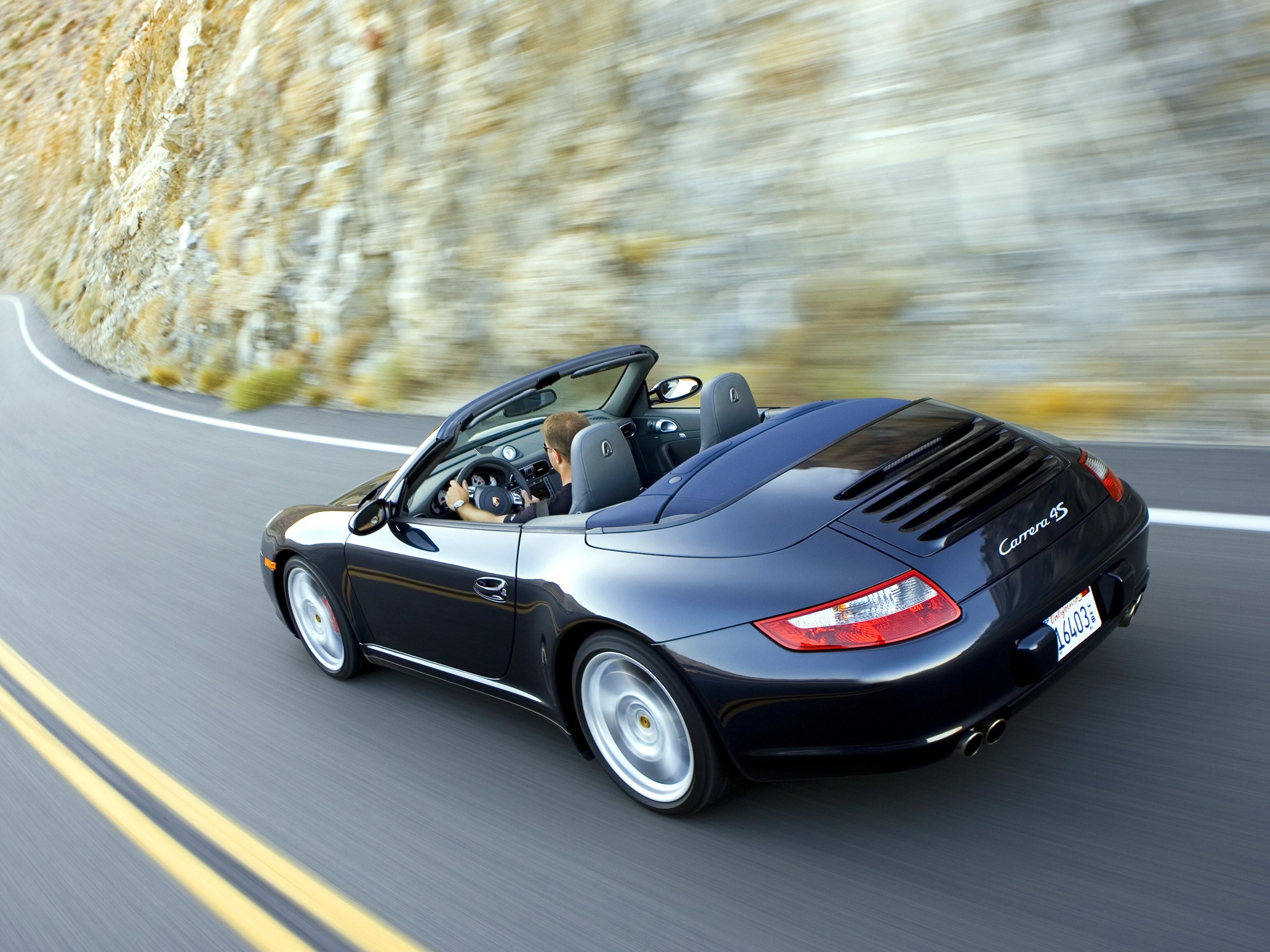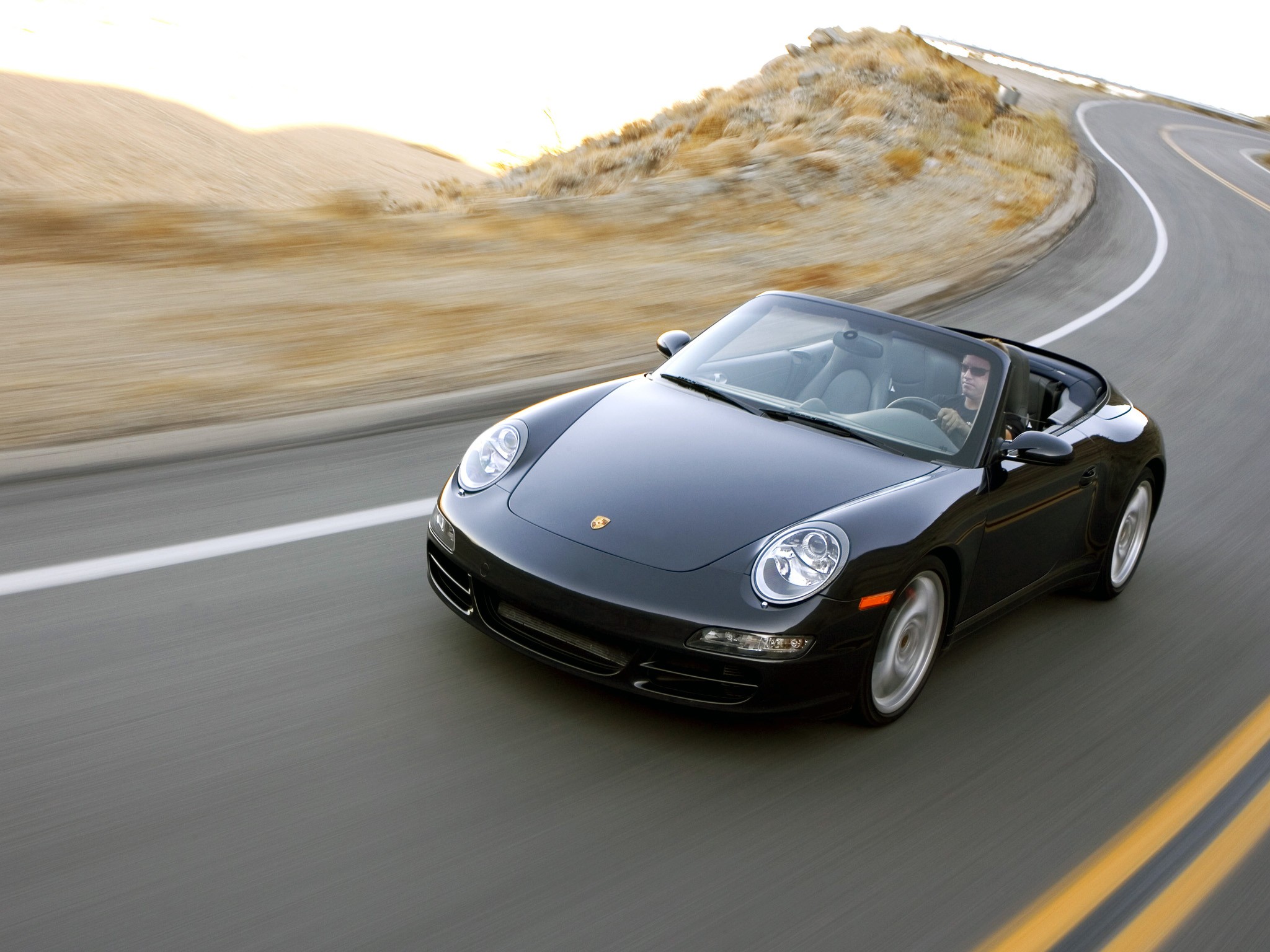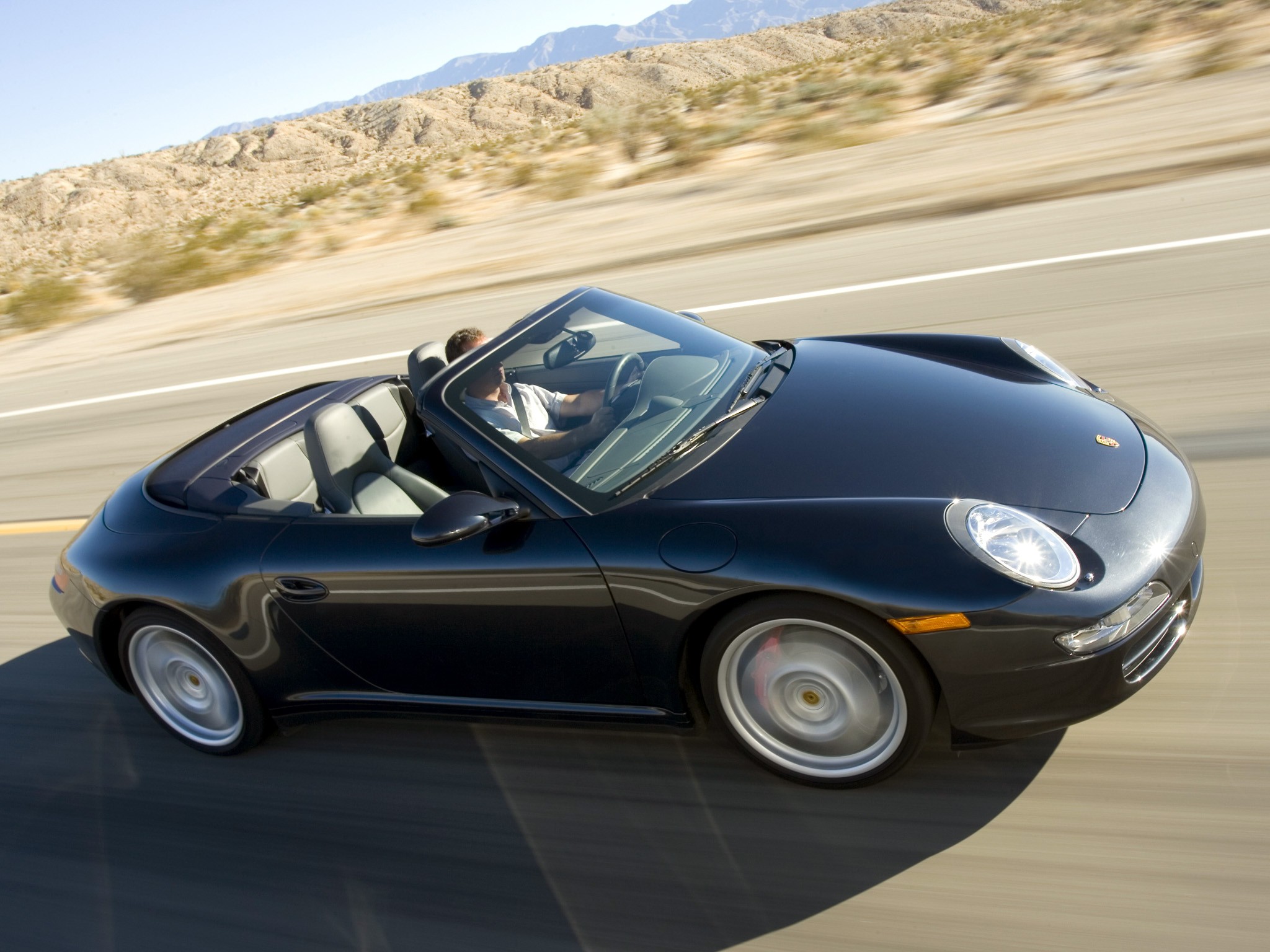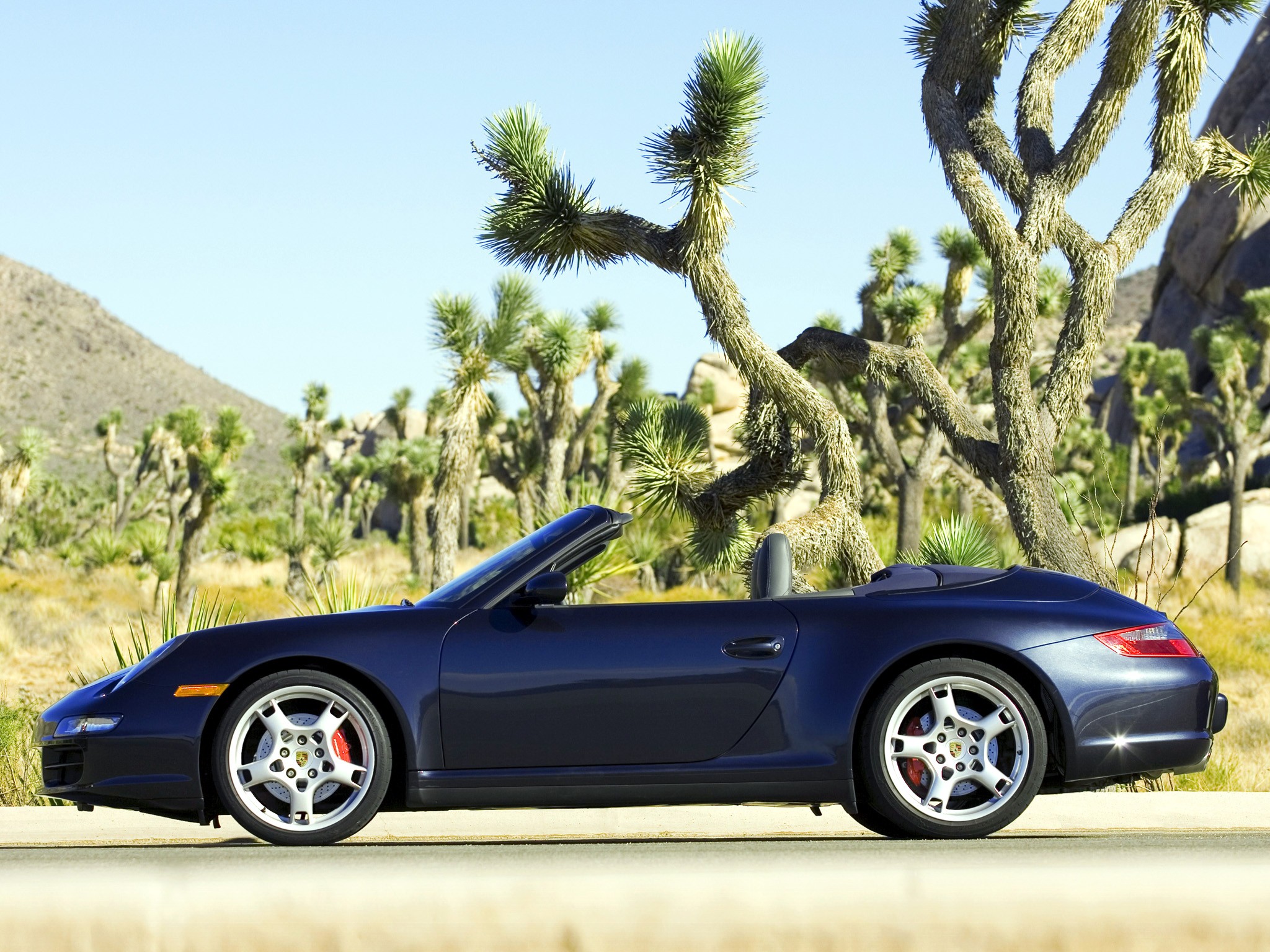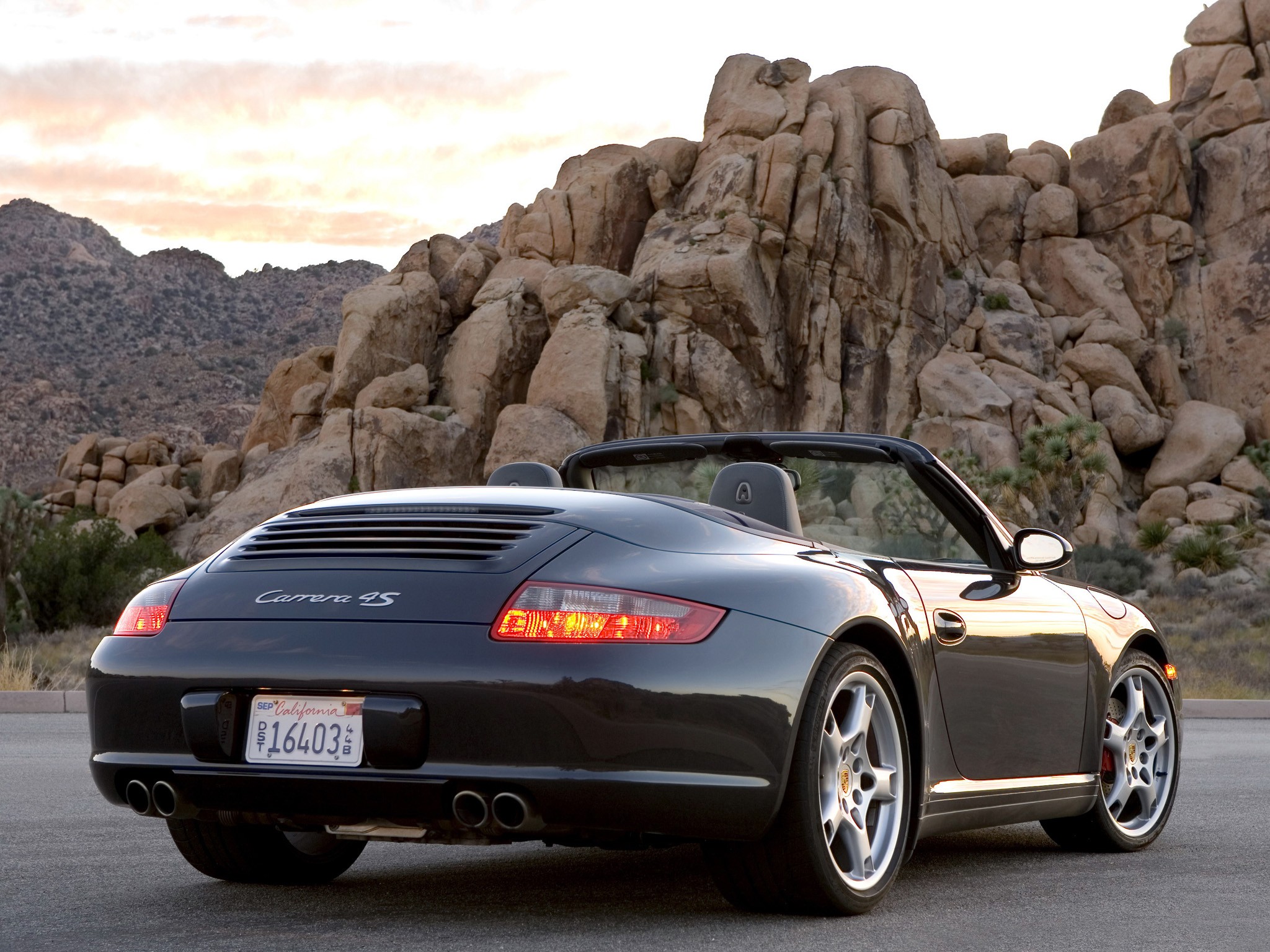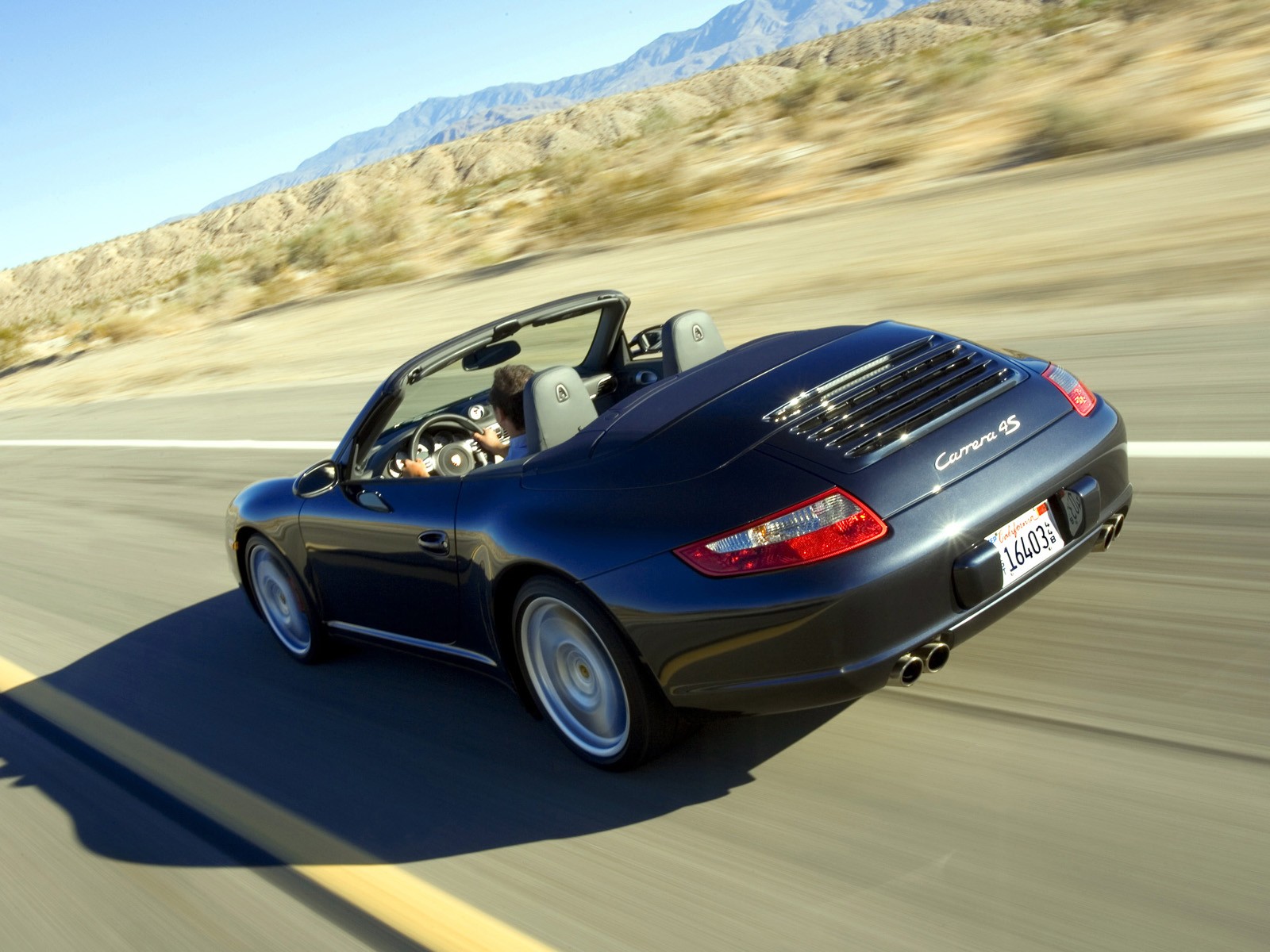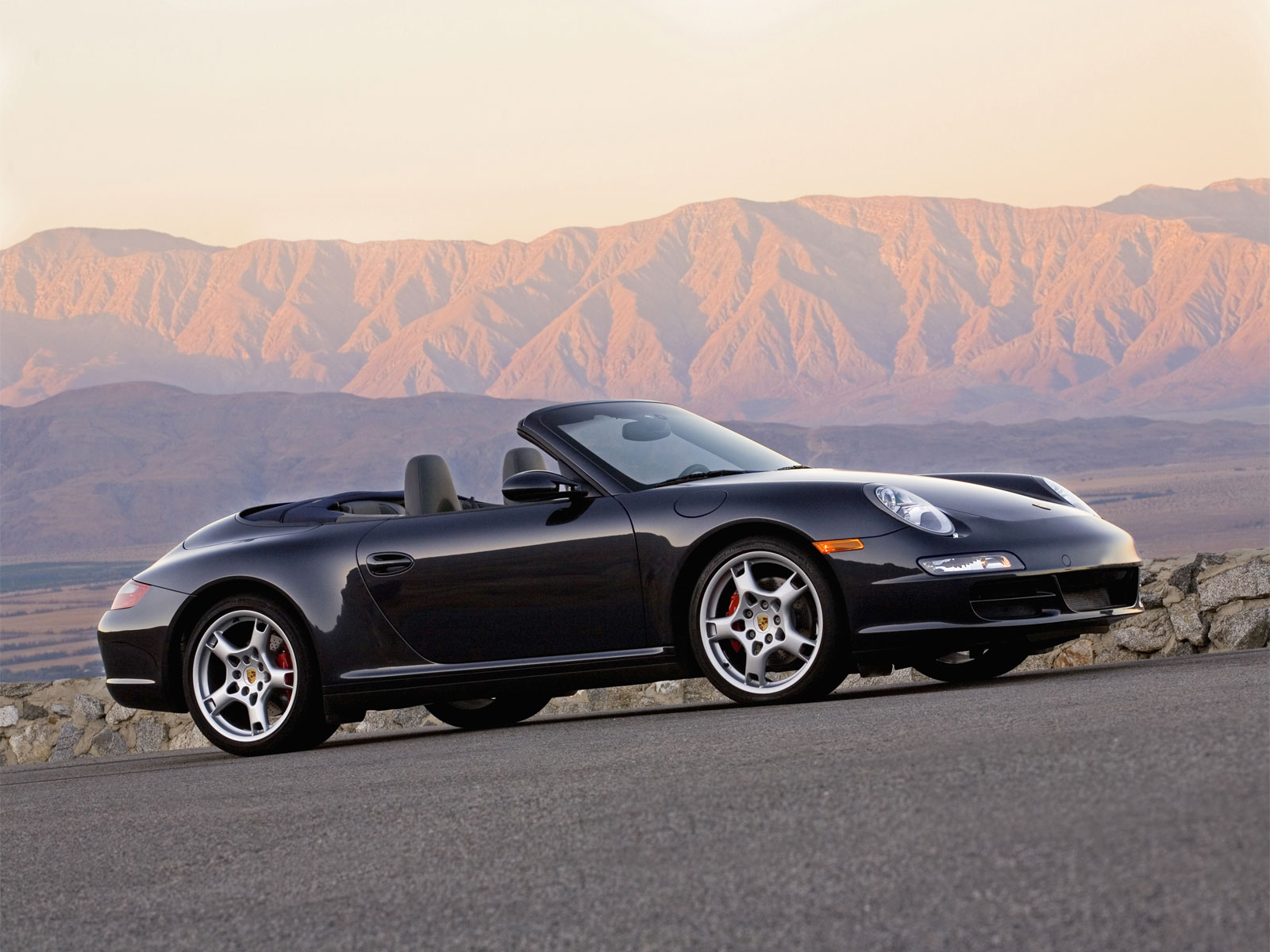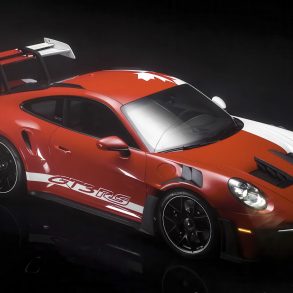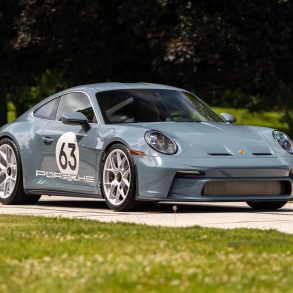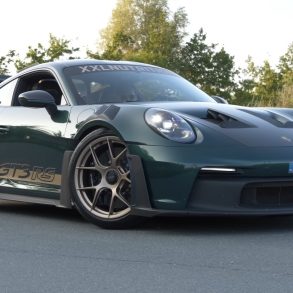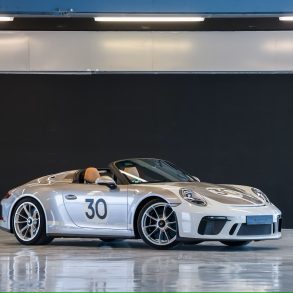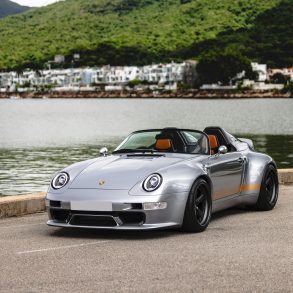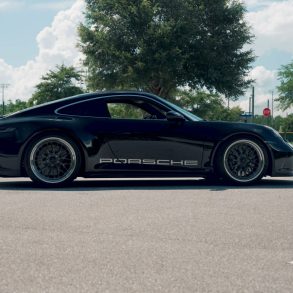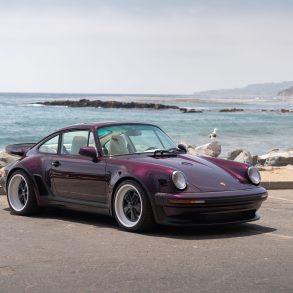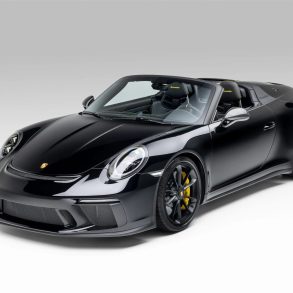(2006 – 2008) Porsche 911 Carrera 4S Cabriolet – Ultimate Guide
While the 997 Carrera 4S coupe sold a healthy 15,056 units between 2006 and 2008, the equally exciting Carrera 4S Cabriolet sold 12,587 units, making it a pretty popular 997 model. The reason is pretty simple. Here was a convertible 911 that had a gorgeous wide-body stance, all-wheel drive traction for inclement weather and the extra power of the potent 3.8 L Flat 6 that was good for 350 bhp and 295 ft lbs of torque. This was probably the first convertible 911 that was as good a performer as it coupe siblings with the added benefit of open top driving in the summer with the comfort of being a great daily driver all year round.
The convertible was only 85 kilograms (180 lbs) heavier than the coupe, which made it just as fast as the sporty Carrera S Cabriolet. The added traction from that all-wheel drive system helps. The 997 Carrera 4 was based on the same platform with its predecessor but enhanced. It had the same rear wide fenders as the Carrera 4S and the Carrera S and it offered an enhanced all-wheel-drive system, which transferred between 5 and 40% of the torque to the front wheels. Unfortunately, the Carrera 4 was overshadowed at launch by the Carrera 4 S, which had all of those things, plus a more powerful engine and extra “S” goodies.
Both the Carrera 4 and Carrera 4S have the wider rear tracks than a standard Carrera and S and it makes all the difference in the looks department. The wider tires and wider rear fenders give these models a better stance, a more squat down and get straight to business appeal.
Inside, the Carrera 4S Cabriolet offered four seats but cramped in the rear. It featured the same options as the coupe, plus the wind deflector. That allowed a normal conversation even with the top down at highway speed. To cover or uncover the car, the electric system needed only 20 seconds at speeds up to 50 kph (31 mph).
For the engine, the Carrera 4S we mentioned that 3.8-liter unit that offered a very healthy 350 bhp @ 6600 rpm and 295 ft lbs @ 4600 rpm, but if that wasn’t enough, you could opt to get the X51 package, that gave you a more powerful engine that was good for 375 bhp. Regardless of the option you chose, the flat-six engine was mated as standard to a 6-speed manual, while a 5-speed automatic Tiptronic was optional. 0 – 60 mph took 4.7 seconds (same as the 997 S Cabriolet) and top speed was 179 mph (3 mph slower than the S Cabriolet).
For the 2009 model year, Porsche gave us a revised 911 lineup, all featuring a new Direct Fuel Injection (DFI) engine. Gone was the tiptronic gearbox option, now replaced with a revolutionary (at the time) PDK semi-automatic gearbox. There were also a series of very subtle styling changes. These included larger rear view mirrors, newly-designed 18-inch and 19-inch wheels and new lights featuring LED technology. Thus, the 997.1 Carrera 4S Cabriolet was replaced by the Porsche 911 Carrera 4S Cabriolet (997.2).
Pictures
Press Release
The all-new 2006 Porsche 911 Carrera 4 Cabriolet and 2006 Porsche 911 Carrera 4S Cabriolet – with a sure-footed, four-wheel drive powertrains, the enhanced look that comes with their “wide-body” styling, and with tops that open or close at the touch of a button – are truly sports cars that can be enjoyed year around and regardless of the season.
Both Cabriolets feature flared wheel arches designed to accommodate a widened track, larger wheels and tires and four-wheel-drive powertrains that give the venerable Porsche 911 additional dimensions of dynamic stability, especially in inclement weather conditions.
The 2006 Porsche 911 Carrera 4 Cabriolet and Carrera 4S Cabriolet were designed and developed in parallel with the fixed-roof versions of these Porsche sports cars. Instead of merely taking a Coupe, cutting off its top and then reinforcing its structure with weighty panels, Porsche engineers were able to provide the pleasures of open-top motoring by designing a vehicle that offers the stiffness and strength needed without adding unwanted weight. The result is outstanding dynamic performance with exceptional safety protection.
Porsche enhances the Cabriolet experience
The 2006 Porsche 911 Carrera 4 Cabriolet and Porsche 911 Carrera 4S Cabriolet not only match the Coupes in their top speed potential, but have safety features that provide:
- unparalleled low weight among Cabriolet roof structures;
- a lower center of gravity — and thus better vehicle dynamic control — than even other sports car convertibles;
- opening or closing of the top while the car is moving at speeds of up to 31 miles per hour (50 km/h);
- a standard wind deflector to assure as calm and quiet a passenger compartment whether the top is up or down;
- six airbags as standard equipment, including an auto industry first from Porsche airbags that deploy from the top of the door windowsills to help protect occupants’ heads;
- supplemental safety bars behind each seat that automatically extend when sensors detect a potential rollover situation;
- Porsche Stability Management (PSM), a technology to help the driver maintain control in emergency situations, as standard equipment.
As a further development of this newest generation of Porsche’s wide-bodied, four-wheel-drive 911 sports cars, the 2006 911 Carrera 4 Cabriolet and 2006 911 Carrera 4S Cabriolet are equipped with enhanced Porsche Stability Management technology featuring two new braking system improvements that have been engineered to provide the shortest possible stopping distances, a dynamic category in which all Porsche vehicles are among the best in the world.
Enhanced options list for 2006
The appeal of Porsche’s wide-body Cabriolets grows even more as, just like other 2006 model year Porsche 911 models, the all-new Carrera 4 and Carrera 4S Cabriolets offer options such as two-tone interiors; an electronic logbook to record mileage, journey length, date and time; an extended navigation module that allows drivers to trace back to a starting point even when the road does not appear on the navigation system’s internal map; a tire-pressure monitoring system, and new 19-inch Carrera Sport wheels. Also for 2006, the Porsche Communication Management (PCM) system plays MP3 encoded CDs through the CD unit.
Enhanced safety sensors
For 2006, every Porsche 911 Carrera 4 and Porsche 911 Carrera 4S Cabriolet comes equipped with full-size two-stage front airbags for both front occupants. Both front airbags use an organic-based propellant that not only makes them lighter and more compact, but easier to recycle as well. The passenger seat also features weight sensors that automatically switch off the passenger airbag when child seats are detected. The front airbags are augmented by a side-impact protection system featuring side airbags integrated into the front seats that work in tandem with head protection airbags that deploy upward from their housings in the door windowsills to help protect occupants’ heads.
Porsche was the first automaker to equip its Cabriolets and roadster models with this new side-protection technology.
Another new safety feature is the optional tire-pressure monitoring system. Wheel sensors constantly monitor the air pressure in each tire and alert the driver with two warnings. A “gentle” warning in white text appears on the digital display within the tachometer if air pressure drops by more than 2.9 psi but less than 5.8 psi. This warning appears for 10 seconds each time the car is started. A “stern” warning is displayed in red text on the tachometer’s digital display if air pressure drops more than 5.8 psi or if pressure is falling by more than 2.9 psi per minute. This warning appears as soon as the respective values are exceeded, whether the vehicle is stationary or moving.
Safe by design
The Porsche Cabriolets were designed for safe motoring. In addition to an extra-stiff body shell designed to provide maximized energy absorption in a collision, the Cabriolets have supplemental safety bars with elements made of ultra-strong steel as well as six airbags, all as standard equipment.
A rollover sensor is integrated into the airbag control unit positioned in the middle of the car. It deploys the supplemental safety bars and activates the seat-belt tensioners when it recognizes the dynamic forces that could lead to a rollover situation.
Lower center of gravity
Contributing to the dynamic capabilities of both the 2006 Porsche 911 Carrera 4 Cabriolet and Porsche 911 Carrera 4S Cabriolet is a carefully designed top. While fully suited for even the coldest winter weather, the top weighs only 93 pounds (42 kilograms) — including all of its system components. This represents only half of the weight of a collapsible metal roof like those used on some premium-class convertibles.
This lighter weight top and system components lower the center of gravity of the Porsche Cabriolets, enhancing the cars’ dynamic potential.
By designing Coupe and Cabriolet in parallel, Porsche engineers were able to place necessary structural components in the Cabriolets right from the start. As a result, the Cabriolet body-in-white is 5 percent more resistant to torsional bending and 9 percent stiffer in regards to static flexing compared to the previous generation, yet weighs only 15.4 pounds (seven kilograms) more than the Coupe body.
Even with the motors needed to operate its Z-folding top, the 2006 Porsche 911 Carrera 4 Cabriolet and Carrera 4S Cabriolet weigh only about 180 pounds (85 kg.) more than their Coupe counterparts.
The all-weather Cabriolets
The 2006 Porsche 911 Carrera 4 Cabriolet and 2006 Porsche 911 Carrera 4S Cabriolet optimize the driving experience whether the top is up or down, rain or shine.
In inclement weather, water ducts above the doors prevent rainwater from dripping down. Instead, the water flows into a door-seal drain in the A pillar (next to the windshield). The top also features a glass rear window with an integrated defroster.
In top-down weather, the standard wind deflector helps to keep the cockpit calm enough for conversation between driver and passenger, even at considerable rates of speed.
Should the weather change suddenly, the top can be opened or closed, in a mere 20 seconds. It can also be opened or closed in 26 seconds while the car is moving at up to 50 kilometers per hour (31 mph).
The top is designed in a “Z” configuration so that when it folds, it’s outer side faces up and also helps to protect the glass window.
X51 kit boosts already impressive power of the Carrera 4S Cabriolet
Both the 2006 Porsche 911 Carrera 4 Cabriolet and 2006 Porsche 911 Carrera 4S Cabriolet have powerful engines. For those who want even more, the X51 Power Kit is available to boost the output of the already more powerful Porsche 911 Carrera 4S Cabriolet. Featuring revised cylinder heads, carbon-fiber air cleaner housing, an aluminum air intake system, a reprogrammed engine control unit, and revised exhaust manifolds with sport exhaust and specially tuned tailpipes, the kit increases power, cuts acceleration times and increases the top track speed of this special model.
With the kit, the horsepower rating of the Carrera 4S Cabriolet’s 3.8-liter flat six-cylinder engine increases from 355 (SAE) to 381 (SAE).
Nearly two inches wider
The four-wheel-drive versions of the Porsche 911 Carrera Cabriolet are nearly two inches (1.73 inches or 44 mm) wider than their two-wheel-drive counterparts. This extra width is needed to cover the wheels that are part of the enhanced four-wheel drive system.
On the 2006 Porsche 911 Carrera 4 Cabriolet, front wheels are eight inches wide by 18 inches in diameter and wear 235/40 Z-rated tires, while the rear wheels are 11 inches wide, again 18 inches in diameter and shod with 295/35-aspect Z-rated tires.
Meanwhile, the 2006 Porsche 911 Carrera 4S Cabriolet is equipped with 19 x 8-inch front wheels with 235/35 Z-rated tires and the huge 19 x 11-inch rear wheels with 305/30 aspect Z-rated tires.
Such high speed-rated tires are needed on cars capable of such amazing dynamic dexterity.
With its 325-horsepower 3.6-liter horizontally opposed six-cylinder engine, the 2006 Porsche 911 Carrera 4 Cabriolet is capable of accelerating from a standing start to 60 mph (96 km/h) in just 5.1 seconds and reaches 99 mph (160 km/h) in 11.6 seconds. Top speed on the test track for this car is 174 mph (280 km/h). When equipped with the optional Tiptronic S automatic transmission, the Porsche 911 Carrera 4 Cabriolet accelerates to 60 mph and 96 km/h in 5.5 seconds and reaches 99 mph and 160 km/h in 12.6 seconds. Top track speed is still an impressive 171 mph (275 km/h).
With its even more powerful 355-hp, 3.8-liter “boxer” six, the 2006 Porsche 911 Carrera 4S Cabriolet sprints to 60 mph (96 km/h) in a mere 4.7 seconds and closes in on 99 mph in just 11.1 seconds.
Top speed on the test track is 179 mph (288 km/h). The Tiptronic S version accelerates to 60 mph and 96 km/h in 5.1 seconds and reaches 99 mph and 160 km/h in 12.1 seconds. Top track speed is 174 mph (280 km/h).
But like all Porsches, the four-wheel-drive Cabriolets provide balanced dynamic control, with turning and braking capabilities just as impressive as the figures on the speedometer.
All-wheel drive for extra driving dynamics
Porsche’s four-wheel-drive system uses a viscous multiple-plate clutch to send power to a central driveshaft that feeds a front differential to turn the front wheels with between 5 and 40 percent of the engine’s torque. This system of power distribution provides enhanced directional stability and balanced power and traction through turns and on slippery surfaces.
Such a viscous system exhibits outstanding cooling, even under high loads, and also is able to handle large changes in engine torque, for example, under all-out acceleration. The viscous coupling also reduces power loss due to friction between the clutch plates, adds only 110 pounds (50 kg.) of weight to the vehicle, needs no maintenance and reduces potential drivetrain distortion under extreme braking.
Torque split to the front wheels automatically adjusts between 5 and 40 percent to maintain superior traction. By sending no more than 40 percent of power to the front wheels, the four-wheel-drive 911 Carrera models exhibit dynamic characteristics similar to the rear-drive versions, so they will not understeer or “push” toward the outside over the front wheels in turning maneuvers.
Porsche Stability Management is on all Porsche 911 Carrera 4 Cabriolet and Porsche 911 Carrera 4S Cabriolet
Porsche Stability Management (PSM) coordinates data from various sensors to detect any loss of grip and helps the driver maintain stability by applying braking to individual wheels and, if necessary, by reducing engine torque.
The latest iteration of PSM benefits from advanced anti-lock brake sensors that take their readings not from conventional wheel pulses but from multi-pole seats fitted directly on wheel bearings. These improved signals allow more precise processing and control. Instead of conventional shaft valves, linear solenoid valves adjust brake pressure with nearly infinite precision. To provide pressure more quickly, a new hydraulic pump is used, while a pre-charging pump and its connections are eliminated, reducing system weight by 25 percent, or 6.6 pounds (three kg).
Another PSM enhancement allows for more control by the enthusiast driver. PSM can be turned off via a switch on the dashboard. In an earlier generation, PSM automatically reactivated whenever the brake pedal was depressed, but this latest version reactivates only when the pedal is pushed hard enough to activate the anti-lock system on at least one front wheel. For the enthusiast driver, this change allows more dynamic freedom, including slight use of the brakes in curves.
Milliseconds matter in reducing stopping distances
In regard to the enhanced braking system on the four-wheel-drive Coupes, one of the new functions “pre-fills” the brake system when the driver suddenly pulls his or her right foot off the accelerator. Because such a reaction by the driver is characteristic of an upcoming emergency braking maneuver, the system instantaneously pumps brake fluid from the PSM hydraulic unit to the brakes at each corner of the car. This eliminates the “air lag” between the brake pads and the brake discs so the pads already are directly next to the discs by the time the driver presses down hard on the brake pedal.
The new pre-filling pump activates within 40-60 milliseconds after the driver releases pressure from the gas pedal. As a result, brake pads are in their optimum position for maximum braking within 100 milliseconds of the driver’s reaction.
The second new function of the enhanced PSM system hastens the build up of pressure in the braking system when the driver presses down on the brake pedal quickly but with less than full force. The system thus can reach the anti-lock braking threshold more quickly, providing maximum braking power and shortened stopping distances.
This new system also offers the experienced enthusiast driver the option to modulate the brakes under extreme dynamic driving conditions . For example, should the driver stop increasing pedal pressure or even reduce the pressure exerted on the brake pedal, any additional pressure built up by the system also is reduced.
However, this “pressure booster” aspect of the enhanced braking system does not always cut in. For example, if the driver already is pressing down on the brake pedal hard enough for optimum stopping power on all four wheels, any further increase in pressure would be unnecessary and the function therefore remains inactive. It also is inactive when the “Sports” button — part of the optional Sports Chrono Package Plus — is active and the PSM has been switched to its “off” position.
Larger master brake cylinder for the Porsche 911 Carrera 4S
Because of the greater potential for extreme dynamic capability of the more powerful 2006 Porsche 911 Carrera 4S Cabriolet, it is equipped with an even larger master brake cylinder. Like the rearwheel drive 911 Carrera S, the 911 Carrera 4 Cabriolet has an enhanced master cylinder with a 1-inch (25.4 mm) piston diameter while the Porsche 911 Carrera 4S Cabriolet has a 1.06-inch (26.99 mm) piston diameter.
As a result, the four-wheel-drive models give their driver the same safe feeling on the brakes as the lighter two-wheel-drive versions.
Like all Porsches, the 2006 911 Carrera 4 Cabriolet and 911 Carrera 4S Cabriolet are equipped with large brake discs. Those on the Carrera 4 measure 12.52 inches (318 mm) for the front wheels and 11.77 inches (299 mm) at the rear. On the Carrera 4S, discs are 12.99 inches (330 mm) for each wheel.
Both four-wheel-drive cars have four-piston monobloc fixed brakes calipers at each wheel, with the larger calipers used on the Carrera 4S Cabriolet painted bright red.
Porsche Ceramic Composite Brakes available
To further enhance braking power, Porsche Ceramic Composite Brakes (PCCB) are available as an option on both the 2006 Porsche 911 Carrera 4 Cabriolet and the Porsche 911 Carrera 4S Cabriolet.
Ceramic composite brakes were developed for high-level motorsports competition and were first used on a road car in the Porsche 911 Turbo. Instead of metal, the 13.78-inch (350 mm) brake discs are a ceramic composite material — carbon impregnated with liquid silica, then hardened into a very rigid, lightweight and non-corroding brake disc that weighs half as much as standard steel discs. This reduces unsprung weight and enhances dynamic capabilities.
Special high-friction brake linings are used to provide amazingly high and consistent levels of friction during application. Because of their extremely hard surface and freedom from corrosion and the damage it can cause, ceramic brakes reduce brake pad abrasion. They also provide maximum stopping power even in wet conditions.
Four-wheel drive models gets special aerodynamic tuning
Even with their wider bodies, the 2006 Porsche 911 Carrera 4 Cabriolet and 911 Porsche Carrera 4S Cabriolet have outstanding aerodynamic qualities. The 911 Carrera 4 has a coefficient of drag of only 0.30 and the Porsche 911Carrera 4S has an even lower 0.29 Cd despite having larger tires.
One reason for the more powerful car’s lower drag figures is the fact that it rides 0.39 inches (10 mm) closer to the road surface because it comes with Porsche Active Suspension Management (PASM).
The four-wheel-drive models also benefit from a separate sill cover with a rubber lip that acts as an air spoiler for the rear wheels. These spoilers direct air around the larger rear wheels and tires and thus minimize air resistance.
Another aerodynamic enhancement are NACA ducts (named for the U.S. National Advisory Committee for Aeronautics, predecessor to the NASA Space Agency) in the under tray that covers the bottom of the Porsche 911 Carrera 4 Cabriolet and Porsche 911 Carrera 4S Cabriolet. These special, pearshaped air scoops reduce drag and air resistance while directing air to cool the front drive system.
Two suspension choices
The 2006 Porsche 911 Carrera 4 Cabriolet comes with a standard suspension, while Porsche Active Suspension Management (PASM) is available as an option (standard on the Porsche 911 Carrera 4S Cabriolet).
PASM, which lowers the car almost 0.4 inches (10 mm) from the standard ride height and features several electronic technologies, is standard on the 2006 Porsche 911 Carrera 4S Cabriolet.
The front axles of the four-wheel-drive model vary from those on the rear-drive models because of their constant speed drive shafts and special swivel bearings with additional openings that provide the extra space required for front-wheel drive. Springs and dampers also are modified to handle high loads acting on the front axle.
The rear axles are not changed from the two-wheel-drive models, though the anti-roll bar is modified to provide for higher dynamic loading.
The front track on both the 911 Carrera 4 and Carrera 4S Cabriolet is 58.6 inches (1,488 mm), while the rear track is 60.9 inches (1,548 mm).
Porsche Active Suspension Management
Porsche Active Suspension Management (PASM) — optional on the 911 Carrera 4 and standard on the 911 Carrera 4S — uses active damping to provide two suspension system settings, one designed for an athletic yet comfortable ride and the other for performance driving situations.
By pressing a button on the center console, the driver can switch from “PASM Normal” to “PASM Sport.” Even in normal mode, the PASM suspension lowers the car by 0.39 inches (10 mm) compared to the standard Porsche 911 Carrera or Porsche 911 Carrera 4 Cabriolet suspension setup. When switched into its Sport setting, PASM activates a firmer damper control map to provide extreme agility and dynamic control that minimizes body roll.
In testing at Germany’s famous Nürburgring racing circuit, the PASM Sport setting produced lap times an average of five seconds faster than with the standard suspension setup.
But there are significant advantages to PASM even when left in its Normal setting, where the electronically controlled technology automatically adjusts to changes in driving style, gradually becoming firmer to response to increasing dynamic forces.
The PASM system combines continuously adjustable shock absorbers, a pair of accelerometers — one in the front right damper dome, the other in the left rear — that determine vertical movements of the car’s body, and an electronic control unit that has access to steering angle, road speed, brake pressure and engine torque figures.
Carefully monitoring all parameters, the system provides optimum control for each wheel with active dampers. These shock absorbers include a special internal bypass valve that opens and closes to increase or reduce oil flow as needed for enhanced control while providing enhanced ride comfort.
Should the electronic controls encounter a problem, the bypass valve automatically closes, putting PASM into its hardest position to help ensure a safe driving mode.
Settings for nearly any driving situation
PASM is equipped with five special software modules — lane change, vertical control, lateral acceleration, brake and load change — to provide optimum settings for many driving conditions.
Lane change module: In response to rapid movements of the steering wheel in a sudden maneuver, the system instantaneously increases damper forces on both axles, reducing any tendency toward swaying or rocking.
Vertical control module: In the normal program, damper forces increase whenever vertical movement of the car’s body exceeds a threshold, for example, when driving on a bumpy surface. This reduces any risk of the body starting to rock. However, when in the sport program, the system reduces the damping effect to maintain wheel contact with a rough surface, reducing the risk of the car “jumping” around.
Lateral acceleration module: In the normal program, damping varies through a curve and adjusts with road speed and lateral acceleration.
Brake module: As soon as the driver applies the brakes, PASM firms damping to reduce body dive, ensuring faster transmission of brake forces to the road. Then, at a certain point in the braking process, the system switches to softer damping, with different forces applied in the front and rear of the car. This ensures better surface contact and shortens stopping distances, even on rough roads.
Load change module: In all-out acceleration, with the driver lifting off the accelerator while shifting gears, the control maps are adjusted for the front and rear axles. In the normal mode, harder damping is used briefly to prevent too much squat. In the sports mode, a softer damper response is used to improve traction, for example, on a rough road surface.
Larger fuel tank
Another difference between the two- and four-wheel drive versions of the Porsche 911 Carrera is the larger fuel tank in the 911 Carrera 4 Cabriolet and 911 Carrera 4S Cabriolet. Because of changes in the internal design of the front section of the four-wheel-drive cars, a different and larger fuel tank is used, providing approximately three quarts (three liters) of additional capacity.
Optional tire pressure monitor
Another new safety feature is the optional tire-pressure monitoring system. Wheel sensors constantly monitor the air pressure in each tire and alert the driver with two warnings. A “gentle” warning in white text appears on the digital display within the tachometer if air pressure drops by more than 2.9 psi but less than 5.8 psi. This warning appears for 10 seconds each time the car is started. A “stern” warning is displayed in red text on the tachometer’s digital display if air pressure drops more than 5.8 psi or if pressure is falling by more than 2.9 psi per minute. This warning appears as soon as the respective values are exceeded, whether the vehicle is stationary or moving.
Powerful 3.6-liter engine in the Porsche 911 Carrera 4 Cabriolet
Porsche’s familiar 3.6-liter, horizontally opposed six-cylinder “boxer” engine provides the 2006 Porsche 911 Carrera 4 Cabriolet with 325 (SAE) horsepower and 273 pound-feet of torque at 4,250 rpm.
Crucial to the engine’s outstanding performance is Porsche’s patented VarioCam Plus valve management technology that combines camshaft control on the intake side with variable valve lift. VarioCam Plus adjusts camshaft position to provide continuously adjustable valve timing and incorporates two camshaft profiles and two sets of tappets to vary valve lift and duration. This system both fattens and smoothes the torque curve while reducing emissions.
To provide optimum oil flow through the alloy engine block and cylinder heads, Porsche uses integrated dry sump lubrication and three oil pumps — one in the crankcase and additional pumps within each cylinder head, thus assuring proper lubrication despite the forces of hard acceleration, braking or cornering.
The oil pump on the 4-5-6 cylinder head is combined with a pneumatic vane-cell pump to provide necessary vacuum for the brake servo as well as the engine and transmission control systems. This technology greatly reduces hydrocarbon emissions following a cold start and engine warm-up.
Because engine oil level is monitored electronically every time the car starts, the engine has no need for the traditional dipstick. This is yet another example of Porsche engineers’ dedication to reducing unnecessary components and to make the Porsche 911 Carrera 4 Cabriolet as lightweight as possible.
Even more powerful 3.8-liter engine for Porsche 911 Carrera 4S Cabriolet
To create the more powerful 3.8-liter engine that provides 355 (SAE) horsepower for the 2006 Porsche 911 Carrera 4S Cabriolet, engineers did more than simply increase the bore diameter by 0.12 inches (3 mm). They changed the intake manifold and modified the intake camshaft lift pattern. Injector angles were changed to enhance fuel flow to the center of the combustion chamber. This enhanced fuel/air mixture also reduces exhaust emissions, even after a cold start, and increases torque throughout the power curve. A short-pipe exhaust manifold for the 911 Carrera 4S engine further reduces emissions.
The intake system was further designed to provide less resistance. A Helmholtz resonator is used to enhance acoustics. This provides more than 18 cubic inches (0.3 liters) of additional resonance volume between the hot-film air mass meter and the throttle butterfly and is activated between 5,000 and 6,000 rpm to reduce oscillations in intake sounds. Porsche has applied for a patent for this technology that provides a deep, throaty sound without aggressive peaks.
Higher combustion forces produce more power but also more torsional crankshaft vibration, so Porsche engineers integrated a vibration damper in the pulley at the end of the crankshaft. While conventional vibration dampers are made of cast iron, Porsche engineers devised an aluminum damper that reduces weight by some 3.3 pounds (1.5 kg) while controlling vibrations to a level even lower than the 3.6-liter engine.
Amazingly, the 3.8-liter engine weighs no more than the 3.6-liter unit, thanks to its lighter intake manifold.
While the 3.8-liter engine uses twin radiators like the 3.6-liter powerplant, it has a higher performance cooling pump and an oil/water heat exchanger with two additional cooling layers.
Six-speed manual transmission
To deal with the Porsche 911 Carrera 4S engine’s 295 pound-feet of torque, Porsche upgraded its six-speed manual transmission, which is also used in the 911 Carrera 4 Cabriolet.
Steel rather than brass synchronizing rings as well as thick shafts and wide gears provide strength, yet the transmission’s weight is kept down by using extra-thin aluminum in the oil chamber walls. The transmission’s internal architecture saves weight and reduces splash effect and flow losses, thus increasing the gearbox’s efficiency.
The gearbox uses wear-resistant carbon-coated first, second and third-gear synchronizing rings, with triple synchronizing for first and second gears and double synchronizing for third gear while retaining single synchronizing for gears four, five and six. The driver benefits from reduced force and shorter travel in gear changes.
Tiptronic S is a versatile gearbox
Tiptronic S is Porsche’s optional automatic transmission that makes manual gear selection available through either the lever on the floor console or by switches on the steering wheel.
Normally, the lever must be moved into its manual position, but this five-speed unit allows the driver to ignore the lever and simply use the thumb switches for momentary gear changes, such as passing or to downshift for a curve.
To match the power of the 3.6- and 3.8-liter engines, the Tiptronic S was enhanced in several ways. For example, stall speed was increased so the converter lock-up clutch is closed and power flows more smoothly. Instead of making the first-second shift at 6,900 rpm under full power acceleration, Tiptronic S holds first gear until the engine achieves 7,200 rpm. Oil pressure built-up and clutch plates were adjusted for smoother shifts.
To keep the enhanced Tiptronic S operating at proper temperatures, the gearbox is equipped with an additional oil/water heat exchanger with two additional cooling layers and with a more powerful coolant pump.
Throttle tip-in mimics enthusiast’s driving technique
To mimic the way an enthusiast driver manipulates the accelerator, brake and clutch, engine management software produces a slight boost in engine speed (blips the throttle) during aggressive downshifting. This shortens shift time and enhances gearshift mesh.
With the Tiptronic S selector lever is in its manual mode and the PSM OFF switch activated, the transmission will not shift up even when the engine reaches the rev limiter. This allows the enthusiast driver to drive with the engine near its rev limit while maintaining the selected gear.
Variable-ratio steering
The 2006 Porsche Carrera 4 Cabriolet and Carrera 4S Cabriolet come with variable-ratio steering to help enhance agility on winding roads while helping maintain stability at higher speeds, such as those achieved on Germany’s famed autobahn.
When the steering wheel is turned within 30 degrees of its centered position, the steering ratio remains similar to that on the previous generation 911. This helps to assure a smooth and calm driving experience, even on rough.
However, when the steering wheel angle exceeds 30 degrees from center, the ratio become more direct, reducing lock-to-lock from 2.98 to 2.62. This gives the driver better control both on winding roads and in slow-speed parking maneuvers.
In addition to the variable ratio technology, the Cabriolets, like the Coupes, have steering columns that tilt and telescope to better fit every driver. The wheel can be adjusted by 1.57 inches (40 mm) in height and reach. The steering system also includes an electric steering wheel lock integrated into the car’s anti-theft immobilizer system.
Interior design enhances the driving experience
The interior of the 2006 Porsche 911 Carrera 4 Cabriolet and 2006 Porsche 911 Carrera 4S Cabriolet provides an environment with luxury accoutrements for highway cruising and the daily drive to work, but also with the features that enthusiast drivers need for autocross and track-day activities.
Sport Chrono Package Plus
A clock-style gauge mounted on top of the dashboard indicates that a 2006 Porsche 911 Carrera 4 or 911 Carrera 4S Cabriolet is equipped with the optional Sport Chrono Package Plus feature that not only records lap times, but enhances the vehicle’s performance in such an environment by allowing the driver to engage more aggressive electronic control maps for the Motronic engine management system, Porsche Stability Management (PSM), Porsche Active Suspension Management (PASM) and Tiptronic S transmission (on vehicles equipped with these options).
The revised Motronic maps strongly favor performance over comfort and provide even quicker engine response, not only on deployment but also on release of the throttle. Even the Tiptronic S transmission makes its shifts more aggressively. Further, PSM thresholds, including ABS settings, allow more lateral slip before intervention and PASM switches to its firmer setting to provide more agility in cornering.
However, in some instances, such as on wet pavement, a softer suspension setting can be advantageous so the driver using Sport Chrono can easily press the PASM button to return to the normal damper settings.
The Sport Chrono package includes a digital/analog stopwatch function (activated by a button on the stalk on the left side of the steering column) and uses the screen of the Porsche Communication Management (PCM) for graphic display and review for this data.
A choice of steering wheels
The standard steering wheel in the Porsche 911 Carrera 4 Cabriolet and 911 Carrera 4S Cabriolet has a dynamic three-spoke design and is adjustable both in height and reach. In keeping with the engineering theme of lightweight technology, the wheel is supported by a composite magnesium structure that reduces the weight of the steering wheel assembly.
A multifunction steering wheel also is available. This wheel allows the driver to operate audio, navigation and telephone equipment via controls mounted on the steering wheel. A rotary knob on the left-hand steering wheel spoke controls audio volume, which can be muted by pressing the knob. A knob on the right-hand spoke accesses menu points on the Porsche Communication Management (PCM) system. Pressing the knob selects individual items. The two buttons on the lower steering wheel arm control the telephone.
In addition to the standard leather colors that match the rest of the interior, the multifunction steering wheel is available with wood grain aluminum or carbon trim on its outer ring.
Four seating options
Driver and passenger seats in the Porsche 911 Carrera 4 Cabriolet and 911 Carrera 4S Cabriolet feature a Porsche-patented system engineered to better absorb vibration on long trips. Of course, they also provide outstanding lateral support to keep the driver and passenger in place when experiencing high lateral acceleration through curves.
The seats also are designed to accommodate taller drivers and passengers. Pedals are positioned closer to the firewall to better accommodate drivers with long legs.
The seats are mounted close to the floor pan to help keep the center of gravity as low as possible. This positioning also created more headroom for taller occupants.
Lightweight technology is used in the seat structure. Compared to the seats used in the previous generation of the 911, the seats in the 911 Carrera 4 Cabriolet and 911 Carrera 4S Cabriolet are more than six pounds (3 kg.) lighter yet also more stable.
The standard front seats are adjustable in six directions — fore and aft, height and backrest angle. Height adjustment is made through a mechanical step function positioned between the seat and the doorsill. Backrest angle is electrically controlled.
All-electric seats are available and adjustable in 12 directions, including the angle of the seat cushion and through lumbar support comprising four air chambers. These seats also have a memory feature.
Sport seats with even greater lateral support, both in the seat cushion and shoulder area, are available. These seats also have firmer padding.
Adaptive sport seats provide a fourth option. They combine the sports design with electrical controls. These seats have four-dimensional adjustment that includes adjusting the width to fit the occupant.
Large instrument display
The five dials that comprise the instrument panel are positioned to provide outstanding readability. The faces of the dials are black in the Porsche 911 Carrera 4 Cabriolet and have an aluminum-look finish in the Porsche 911 Carrera 4S Cabriolet.
The tachometer is the largest and center gauge and features a digital display beneath the rev counter so the driver can check speed and engine rpm in a single glance.
The separate analog speedometer includes overall and trip odometers and is located just to the left of the tachometer. The gauge just to the right includes coolant temperature and fuel indicators as well as the clock. The oil temperature gauge is at the far left of the cluster with the oil pressure gauge at the far right.
Gauges have white light-emitting diodes that enhance illumination for night driving.
Keeping the cabin comfortable
Automatic climate controls with air and pollen filtration are standard equipment. The control for the heat, air conditioning and ventilation (HVAC) systems are integrated into the center console near the switches for seat and rear-window heaters. Airflow through the HVAC system is optimized with large pipes as well as side vents.
Porsche Communications Management is standard equipment
Porsche Communication Management (PCM) is included as standard equipment in both 2006 Porsche 911 Carrera 4 and 911 Carrera 4S Cabriolet models. An optional DVD-based navigation system is available for the PCM. The navigation DVD is located in the luggage compartment, thus allowing the slot in the system in the center console to be used for playing audio CDs.
The navigation module allows rapid availability of routes and map updating and 23 zoom stages to a resolution of some 55 yards (50 meters).
The PCM system, which controls many functions including the navigation system, can now read MP3 encoded CDs and play them through the CD unit.
PCM also offers a new optional electronic logbook that allows automatic recording of mileage, journey length, date and time as well as the starting point and destination address for every trip made. An optional extended navigation module includes “back-trace” technology so you can find your way back to your starting point even when the roads you travel may not appear on the navigation system map.
Also standard on PCM is a Sound Package Plus, which includes nine speakers with three times the usual transmission area and with an external analog amplifier for outstanding sound in all driving conditions. The system includes two 0.75-inch (19-mm) tweeters and one 2.5-inch (70-mm) mid-range speaker in the instrument panel, two 4-inch (100-mm) mid-range speakers and two 8-inch (200-mm) woofers in the doors and a 4-inch (100-mm) wide-band speaker in the rear section of the passenger compartment.
The external analog amplifier is located in the luggage compartment and supplies the woofers in the doors and the mid-range speakers in the instrument panel.
A six-disc CD changer is available as an option.
Optional Bose Surround Sound System
The Porsche 911 Carrera 4 Cabriolet and Carrera 4S Cabriolet are available with a Bose Surround Sound System with 13 speakers and a seven-channel digital amplifier integrated into the MOST bus ensuring outstanding sound quality.
The heart of the Bose Surround Sound System is a digital amplifier with a 5 x 25 watt output and additional support from integrated and external 100-watt switching terminals. Active electronic equalization adjusts the reproduction of sound to specific acoustic conditions so all passengers enjoy a sound experience.
The system includes Bose’s AudioPilot technology that automatically adjusts frequency levels to compensate for wind or road noise inside the vehicle. A special microphone in the steering column cover picks up such noises.
Speakers used in the Bose Surround Sound System are Neodym units that are more compact, lighter and have better performance than conventional speakers. A Neodym iron boron magnet generates a magnetic field 10 times more powerful than a conventional speaker magnet.
The Bose Surround Sound speakers include two 1-inch (25-mm) tweeters and one 2.5-inch (70-mm) mid-range speaker in the instrument panel, two 3-inch (80-mm) mid-range speakers and two 8-inch (200-mm) woofers in the doors, two 1-inch (25-mm) tweeters and two 3-inch (80-mm) mid-range speakers in the rear of the passenger compartment and one active subwoofer with two 5.25-inch (130-mm) woofers in the rear parcel shelf.
Plenty of storage area
The 2006 Porsche 911 Carrera 4 Cabriolet and 911 Carrera 4S Cabriolet feature several storage compartments and boxes.
The locking glove box provides nearly 400 cubic inches (6.5 liters) of room and has an integrated rack to hold two CDs and a penholder.
Cup holders are located just above the glove box and are hidden behind a folding cover. When released, the left cup holder emerges in front of the central air nozzle in the instrument panel while the right cup holder rests in front of the front passenger nozzle.
The center console includes more than 90 cubic inches (1.5 liters) of storage capacity as well as a 12-volt outlet and a coin holder. This compartment automatically locks when the central locking system for the doors is activated.
Additional storage pockets are located in the interior door panels with covers that also serve as armrests.
Another large storage area is located behind the rear seats. Tipping the seat backs forward expands this area.
The car’s front-positioned trunk compartment offers 3.35 cubic feet (95 liters) of storage capacity. The interior load volume is 5.5 cubic feet (155 liters).
Cayenne-style electronic network
The 2006 Porsche 911 Carrera 4 Cabriolet and 911 Carrera 4S Cabriolet benefit from a comprehensive electronic network like that introduced in the Porsche Cayenne sport utility vehicle. Thus the 911 assures complete and efficient exchange of data and electronic information by 29 control units throughout the vehicle through an internal high-speed network or CAN-bus (Controller Area Network) and light-wave or digital MOST bus (Media-Oriented System Transport) networks.
Without such electronic networking, features such as Porsche Active Suspension Management would not be possible. The software required for this purpose has been developed under Porsche’s leadership and represents one of the company’s core competencies.
In addition to quicker and more integrated electronic communication with a wider range of functions, this new electronic system is some 11 pounds (5 kg) lighter than the system used in the 2004 model.
Guide-me-home lighting feature
The exterior lighting system includes a guide-me-home feature that can be selected via the light switch. This feature turns the lights on when you leave the car. In addition to headlamps, fog lights, rear lights and license plate lights stay on for 30 seconds allowing the driver and occupants to see obstacles or puddles of water.
Impressive list of options
Included on the option lists for the 2006 Porsche 911 Carrera 4 Cabriolet and 911 Carrera 4S Cabriolet are Porsche ParkAssist, which uses ultrasound to measure the distance and provides an audible warning to the driver, a PCM telephone module, wood grain, aluminum or carbon interior trim, as well as a roof transport rack system. Porsche’s Exclusive and Custom Tailoring programs allow drivers to further personalize their vehicles.
Standard anti-theft warning system
The 2006 Porsche 911 Carrera 4 Cabriolet and 911 Carrera 4S Cabriolet feature a standard anti-theft warning system that uses radar to maintain surveillance of the vehicle interior. Unlike some systems, this sensor is not affected by reflections from bright interior leather surfaces. Also standard is a programmable HomeLink system that can open a garage door or turn on the lights in your home.
Six airbags in every car
Every 2006 Porsche 911 Carrera 4 and 911 Carrera 4S Cabriolet is equipped with six airbags, including two two-stage front and two seat-mounted side-impact airbags. In addition, the Porsche Side Impact Protection (POSIP) system includes two head airbags that deploy upward from their housings in the door windowsills to help protect occupants’ heads. These new airbags provide a flat cushion that inflates to nearly 500 cubic inches (8 liters) and are designed to help protect the heads of the driver and front-seat passenger from broken glass and objects that might enter through the window.
Both front airbags use an organic-based propellant that not only makes them lighter and more compact, but easier to recycle as well. The passenger seat also features weight sensors that automatically switch off the passenger airbag when child seats are detected.
Ultra-high-strength steel provides protection
Due to the use of high- and ultra-high-strength steel as well as improvements in spot-welding and bonding, the 2006 Porsche 911 Carrera 4 and Porsche 911 Carrera 4S Cabriolet bodies are extremely torsionally rigid and flex resistance while still being lightweight.
Particular attention was paid in designing and engineering the areas of the junction of the A-pillars and the roof frame, as well as the safety structure involved in head-on and offset collisions, including the transition between the door and B-pillars. Forces in a collision can be transferred through the door to the rear of the car and thus around the passenger compartment.
A bulkhead crossbar at the front of the car is made from high-strength boron 02 steel and special assembly processes were developed to minimize intrusion in to the foot well in an offset collision.


